
Sea Surgeon's Dispensatory: 1 2 3 4 5 6 7 8 9 10 11 12 13 14 15 16 17 18 19 20 21 22 23 24 25 <<First
The Sea Surgeon's Dispensatory, Page 25
Chemical Medicines
Chemical medicines were discussed in some detail earlier. By way of review, chemical medicines
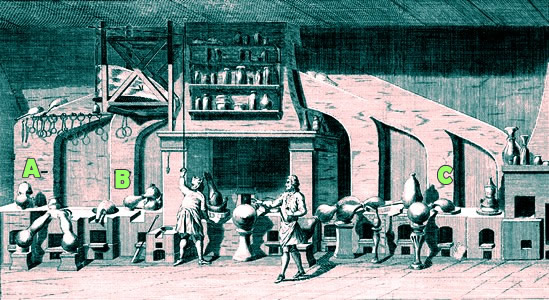
A Variety of Alchemical Furnaces For Distilling Including A - A Furnace with a Bain/Balneum Marie (Double Boiler);
B - Two
Sand Furnaces; & C - A Sand Heat Furnace, From The Universal Magazine, Vol. 8 (1751)
are those that purified, concentrated and otherwise altered to focus the healing powers of simple medicines. This was performed through a variety of chemical processes which primarily involved distilling of their essence through heating.
Several terms will repeatedly appear in this section that are worth explaining in preparation for reading it. This include: calcination - heating the simples to a high temperature to remove moisture and combine the essence of the simple with oxygen; decanting - gradually pouring off the liquid to leave the sediment which precipitated out during heating behind; digestion - heating a simple medicinal to extract its essential components; flowers of elements - condensation of material forming on the top of a closed vessel or the neck of a retort during heating; infusion - soaking a simple in liquid to leech out its essence; luting - sealing the connection point between two containers, often with a clay or clay-like substance; rectifying - repeatedly distilling a liquid to purify it; refrigeratory - A vessel containing cold liquid used to cool heated gasses as they pass through vessels during distilling; subliming - changing a substance into a vapor and then cooling to form a concentrated solid from that vapor.
The vessels used are specific to chemistry as well. Several are named in the various chemical prescriptions including those shown below. They include A - a Receiver, used to collect the essence of materials distilled, B - A Matrass or Bolt-Head used to digest or distill liquids, C - a Retort, or Cucurbit, used to heat and distill liquids with the neck acting as a condenser, D - a Gallipot (or Galley Pot), used to store medicines, and E - a Close Vessel, with a tapered stopper to keep the stored chemical from escaping.
 Chemical Vessels from Traite de la Chymie by French Chemist Nicasius le Fevre (1664) |

Image: Wiki User Mrnatural - Diagram of a Reverberatory Furnace
Some of the chemical distilling processes mentioned in these prescriptions require devices best explained with images as well. Those below include the Alembic, the Bain Marie and the Sand Furnace. The image at right is a diagram of a Reverberatory Furnace.
The elements in this images are A - A Furnace, B - A Retort For Heating Simples, C - A Receiver, D - The Cucurbit, or open-topped Lower Vessel with a neck (which, with B - the head, this makes up a two-part Retort), E - The Lower Vessel of a Bain Marie for boiling water which is used to gently heat the retort, F - The Sand Containers in a Sand Furnace, which are heated to allow for more even heating of a Retort or other vessels and G - The compartment containing the material being heated by a reverberatory [reflecting] furnace.
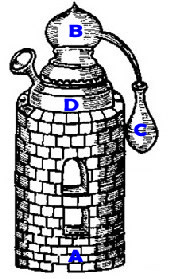 Alembic, The Art of Distillation, John French (1651) |
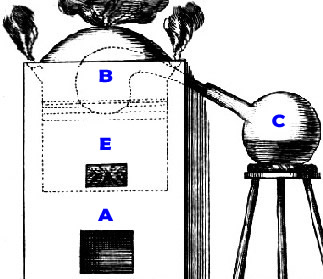 Bain/Balnea Marie, Traite de la Chymie, Nicasius le Fevre (1664) |
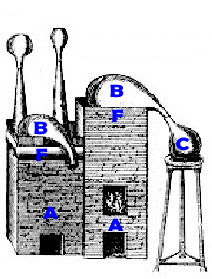 Sand Furnace, A New Method of Chemistry, Herman Boerhaave (1727) |
Many of these processes have already been mentioned in the compounded medicines part of the Sea Surgeon's Dispensatory. The difference between chemical medicines and some of the compounded medicines is not always distinct. In fact, it could be argued that many of the compounded medicines should be classed as chemical medicines, particularly the Waters and some of the compound Oils. However, the Sea Surgeon's Dispensatory follows the convention of the pharmacopoieas and dispensatories of the period which classed such medicines as compound rather than chemical.
Making chemicial medicines was quite a specialized process. It nearly always required a furnace as well as a variety of specialized pieces of distilling equipment such as retorts and receivers. These would rarely be available to a ship's surgeon at sea. As a result, nearly all such medicines would be purchased pre-made on land. However, the recipes are included here for reference.
Antimonium Diaphorticum
Listed in: Moyle: Antimon. Diaphoret.1
Category: Chemical Medicine
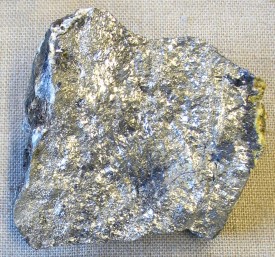
Photo: Aram Dulyan - Antimony
Rx: "Take of Antimony {1 pound} Salt-Petre {3 pounds} powder and mix them exactly, then put them into a red-hot Crucible [an open container that can withstand very high temperatures], by a Spoonful at a time, and let it stand half an hour: remove it before it is quite cold, and put it into a large earthen Pan, almost full either of hot or cold Water. Let it remain there ten or twelve hours, so to dissolve the Salt; then take it out, and if any of the calcin'd Antimony adheres to the Crucible, scrape it off with a Knife. Stir the white Matter about with a clean Stick, and when 'tis settled, decant the Water by Inclination [gradually pouring off the liquid by inclining (tipping) the container]; put on more warm Water, and decant as before: thus repeat the Ablution, until the Antimony is insipid [lacking flavor]. When this is done, put more fresh Water, stir it about, and presently pour it off into another Pan: put on more, and pour it off as before; and so do till all the finest part of the Preparation is wash'd off, and by this means it will be separated form the grosser dirty parts. Having thus separated the finer part, leave it to settle, and gently pour off the Water by inclination. Put the Antimonium Diaphoreticum upon a clean Sheet of whited-brown Paper, and lay it upon a Chalk-stone to suck up the Moisture. Remove it into a very gentle Heat to be perfectly dry'd, and keep it for use in a close Vessel."2
Description: "It is sometimes given with Alexpharmicks [medicines to treat poisoning] in malignant Fevers, and in the Small-Pox and Measles; And likewise in Scobutick [scurvy] and Venereal Diseases, to sweeten and cleanse the Blood. Its Dose is generally small in common Practice being from {5 grains to 1/2 dram}."3
"It is a very great Reproach to Physic [medicine], that the Virtues of a Medicine so long in Use, and so much in Practice as this, should be so little ascertain'd, that at this time it is asserted, that it is possessed of none at all, by very considerable Authors... I can't from Experience say much with Respect to its Virtues; but I have sometimes known a profuse Sweat [to] arise upon taking it, which has been attended with more happy Consequences that those excited by warmer Diaphoretics [medicines that cause sweating - a way to purge unwanted humors from the body]."4
1 John Moyle, The Sea Chirurgeon, 1693, p. 32; 2 John Quincy, Pharmacopoeia Officinalis & Extemporanea, 1719, p. 265-6; 3 Quincy, p. 266; 4 Robert James, Pharmacopoeia Universalis, 1747, p. 827
Aqua Fortis Simplex (Strong Water)
Listed in: Woodall: Aqua Fortis1
Category: Chemical Medicine
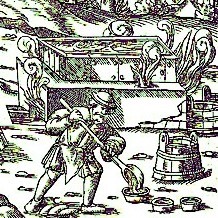
Artist: Peter Schmidt - Vitriol Rcovery (1580)
Rx: "‘Take Vitriol calcin’d [heated to just under its boiling point] almost to a Redness [burnt vitriol] {4 pounds} of Nitre {2 pounds} both made into fine Powder and well mix’d: put the Mixture into an earthen long Neck, or Glass Retort luted [sealed], set it in a Reverberatory Furnace [a reverberatory furnace isolates the material being processed from contact with the fuel, but not from contact with combustion gases]; fit and lute [seal with clay, sand and cut flax] on a Receiver [receiving vessel] to it; kindle a Fire, and proceed exactly as in single Aqua Fortis.’ [‘give a Fire of the first degree2 for three hours; in that time there will come some red Fumes into the Receiver, which will again disappear: then raise the Fire to the second degree, where keep it three hours longer; go on to the third and fourth, where keep it till the Receiver is free from Fumes. When all is cold, take the Receiver off carefully, and keep the Aqua Fortis for use.’]'"3
Description: "Aqua fortis or strong water: I have, to satisfie some Surgeons, put this water into their chests, but for my selfe I see no reason for it, I know no Chirurgicall use it hath which is not far better performed by oyle of vitrioll, wherefore I referre you rather to oyle of vitrioll, for it is a farre sweeter and surer medicine, as at large shall be spoken of in its place."4
"Aqua Fortis appertains rather to Goldsmiths than Apothecaries; which they use in separating Silver from Gold; and thence called, The Separatory Water.... for it melts the Silver and moves not the Gold. Now that same which they have once used, and that hath admitted of a portion of water, or is become ignave [inactive], and of an azure colour, is commonly called Aqua secunda; which all Chirurgeons keep for the Præsidy of such as have got the Plague of Venery [alcoholics]."5
1 John Woodall, the surgions mate, 1617, p. 61; 2 "To make a Fire of the First Degree, two or three coals lighted will suffice to raise a most gentle heat. For the Fire of the second degree, three or four coals will serve, to give such a heat as is able senisibly to warm the Vessel, but so as a hand may be able to endure it for some time. For the Fire of the Third degree, you must cause heat enough to make a Pot boil, that is fill'd with five or six quarts of water. For the Fourth Degree, you must use Coals and Wood together, enough to give the most extream heat of all.", From Nicholas Lémery and Walter Harris, A course of chemistry, 1686, p. 38-9; 3 John Quincy, Pharmacopoeia Officinalis & Extemporanea, 1719, p. 278; 4 Woodall, p. 61; 5 Jean de Renou, A Medicinal Dispensatory, 1657, p. 737
Balsamum Sulphurus Terebinthinatum
Listed in: Tweedy: Bals. Sulph. Tereb.1
Category: Chemical Medicine
Humoral Property: hot2
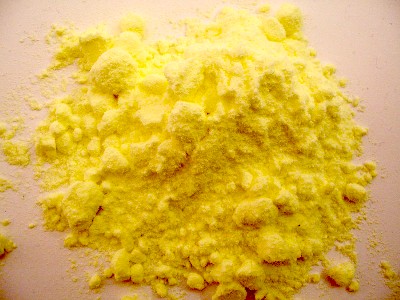
Photo: Wiki User Serpens - Sulfur Powder
Rx: "Take Flowers of Sulphur [yellow sulfur powder] {4 ounces} and Oil of Turpentine {1 pound} place the Mixture in a Sand Furnace [a furnace that heats a container of sand in which the vessels are set], stop the Matrass loosely with another Glass; give a small Fire for one hour, then increase it till the Oil boils gently, in which degree keep it three or four hours; then let it cool, and pour off the impregnated Oil from that which is not dissolv'd."3
Description: "This is an excellent Medicine for all Diseases of the Breast, and likewise for Ulcerations and Obstructions of the Urinary Passages; but is nauseous to take at first, because of an Empyreuma [smell of decomposed vegetable matter], which wears off with long keeping. Its Dose is from 6 to 15 or 20 Drops. Upon fine powder'd Sugar, is the best way to take it, because it will not well mix with any Liquor [liquid]."4
"This Balsam is an extemporaneous [from the Latin 'ex tempore' ("at the time") - a prescription written on the spot for a specific patient with a specific ailment] anodyne [pain relieving] Remedy in Pains of the Nerves, and an excellent Medicine in sanious [fluid discharging], sinuous [winding], weeping, watery, and fistulous Ulcers. Internally taken, it is heating, diuretic, and sudorific [sweat-inducing - sweating was a way to purge unwanted humors from the body]. It is recommended for cleansing and healing internal Ulcers; it is hence too highly commended for Phthisic [tuberculosis], Ulcers of the Kidnies, and for expelling and dissolving of the [kidney and urinary tract] Stone: But the cautious Physician will recommend only the gentle Medicines, and be afraid of those that operate violently. It is certain, that the Urine is soon impregnated with a Violet Smell, upon taking a little of this Balsam."5
1 "158. John Tweedy's Bill for Medicines. November 8, 1743". Privateering and Piracy in the Colonial Period Illustrative Documents, John Franklin Jameson, ed., p. 457; 2 Robert James, Pharmacopoeia Universalis, 1747, p. 810; 3,4 John Quincy, Pharmacopoeia Officinalis & Extemporanea, 1719, p. 317; 5 James, p. 810
Bezoardicum Mineral
Listed in: Tweedy: Bez. Miner.1
Category: Chemical Medicine
Photo: Wiki User Leiem - Butter of Antimony (Antimony Trichloride)
Rx: "Take of rectify'd [refined through repeated distillation] Butter of Antimony [antimony trichloride] {4 ounces} put it into a Retort, and to it Spirit of Nitre [nitric acid] {12 ounces} or {16 ounces} at a time. Place the Retort in a Chimney, to avoid the hurtful Fumes [coming from it while it is heating]. When all the Spirit of Nitre is in, and the Vehemence of its Action is over, put it in a Sand Furnace [a furnace that heats a container of sand in which the vessels are set]; fit and lute [seal] a Receiver to it, and give a gradual fire to the third degree2. When it ceases to drop, let out the Fire; and when cold, take it out and keep it in a Glass well stopp'd from the Air"3
Description: "Its Operation is by Sweat, tho it will also sometimes purge. It is much more efficacious than the Antimonium Diaphorasicum, and will eradicate even Leprosies, and the most obstinate Cases of that kind, if rightly managed. Some account it a Resister of Poisons, and commend it in pestilential Distempers. Its Dose is from {10 grains to 1/2 scruple}."4
1 "158. John Tweedy's Bill for Medicines. November 8, 1743". Privateering and Piracy in the Colonial Period Illustrative Documents, John Franklin Jameson, ed., p. 458; 2 "To make a Fire of the First Degree, two or three coals lighted will suffice to raise a most gentle heat. For the Fire of the second degree, three or four coals will serve, to give such a heat as is able senisibly to warm the Vessel, but so as a hand may be able to endure it for some time. For the Fire of the Third degree, you must cause heat enough to make a Pot boil, that is fill'd with five or six quarts of water. For the Fourth Degree, you must use Coals and Wood together, enough to give the most extream heat of all.", From Nicholas Lémery and Walter Harris, A course of chemistry, 1686, p. 38-9; 3,4 John Quincy, Pharmacopoeia Officinalis & Extemporanea, 1719, p. 271
Calcined or Burnt Vitriol
Listed in: Woodall: Burnt Vitrioll1, Cokethor2; Moyle: Calcanth. Rubif.3
Category: Chemical Medicine
Photo: Wiki User BXXD - Burnt/Calcined Vitriol (Iron III Oxide)
Rx: Burning vitriol is pretty much just what it sounds like. Both sea surgeon John Woodall and physician Jean de Renou suggest it is like burning alum in their text because the processes were so similar. "Alume must be burned in a hot platter till it leave [stops] bubbling, [just] as Vitriol till it lose its colour."4
Physician Robert James explains how to calcine (cook to just below the boiling point) vitriol, which is to essentially 'burn' it in more detail. "Put green Vitriol into an earthen Vessel, and calcine it with an open Fire as long as it exhales any Moisture; then take it out by breaking the Vessel, and set it by for Use, well closed from the Air. The Vitriol is most perfectly calcined, if, at the Bottom and Sides of the containing Vessel, it is become red."5
Description: Burnt vitriol has a variety of names in the period and near-period literature including calcined vitriol (as seen in the prescription) Calcantham Rubefactum and Calcothar.6
Woodall lists both burnt Vitriol and Colcothar (calling it Cokethor or Dead-head) in his book. He subdivides Cokethor into two sub-types by how they are obtained. The first type produces a compound that is different than regular calcined or burnt vitriol and is treated under its own entry. However, Woodall explains that the second type is "from copperas [green vitriol or Iron III Sulfate], after the strong oyle is extracted from it [by heating]."7 This is the same procedure as that used to obtain calcined vitriol as explained above.
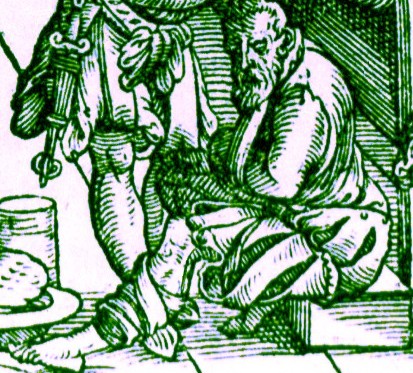
Bandaged Leg Wound, From Ppus Chyrurgicum Artzney Buch, p. 10 (1565)
Of burnt vitriol, Woodall says it "is of great use in Surgerie, namely, to abate spungie flesh in ulcers, and also in all restrictive powder [powders to stop bleeding] for staying of fluxes [flows of blood], and it helpeth well with other fitting simples to siccatrize [heal a wound over with a scar], and also in Lotions and Gargarismes; as is sayd, it is of good use."8
Woodall also advises the use of burnt vitriol in treating 'a carunkell [caruncle - a lesion] or ulceration in the neck of the blad[d]er or passage of the urine' where he explains to the surgeon to "fasten your your medicine [on a searching candle] which you intend to heale the griefe, with; as namely if the disease be a kind of spungie flesh as often it is, a little burnt alumis usti, or vitriolum usti [burnt alum] will be fitting medicines, or what else you know best for such occasions, and print it [with ink on the skin] according to to the depressed part of the waxe into the wax candle and conveigh it warily to that place, and let the waxe light remaine for a short time in the yard [penis], then having a care you keepe it not till the waxe melt too much draw it out, and doe so againe, and alter your medicine upon the searching candle as you see cause, and forget not to use good injections also, which helpe much."9
1,2 John Woodall, the surgions mate, 1617, p. 285; 3 John Moyle, The Sea Chirurgeon, 1693, p. 32; 4 Jean de Renou, A Medicinal Dispensatory, 1657, p. 68; 5 Robert James, Pharmacopoeia Universalis, 1747, p. 802; 6 John Quincy, Pharmacopoeia Officinalis & Extemporanea, 1782, p. 288; 7,8 Woodall, p. 285; 9 Woodall, p. 24
Cerusa (White Lead)
Listed in: Woodall: Cerusa1
Category: Chemical Medicine
Humoral Property: "of a drying nature"2
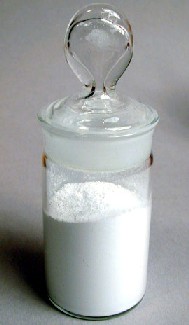
Photo: National Gallery of Art - White Lead
Rx: "Take any Quantity of very thin Plates of Lead, and suspend them in an earthen Vessel, at the Bottom whereof is lodged a sufficient Quantity of Vinegar, so as the Fumes arising from the Liquor [liquid] may surround the Plates; then digest in Horse-dung for three Weeks; during which, if the Plates be not entirely calcined, scrape off the white Powder, and again expose them to the Fumes of Vinegar, till they wholly turn into Powder."3
Description: "The Ceruse, thus prepared, is compounded of the Acid of Vinegar, and dissolved Body of the Lead. This Ceruse is of Use in watery, ulcerous, running Sores, or Diseases of the Skin, being sprinkled thereon. If this fine Powder be drawn along with the Breath into the Lungs, it causes a violent, and almost incurable or mortal Asthma. If received into the Mouth, and swallowed along with the Spittle, it occasions inveterate Distempers in the Viscera [internal organs], intolerable Faintings, Weaknesses, Pains, Obstructions, and, at last, Death itself. ...Let all, therefore, beware of this Poison, which being both without Smell and Taste, proves more pernicious, as it is the less discovered, and does not shew itself till it had destroyed the Body."4
"[Cerusa is] ...mix'd with many of the offininal Unguents and Emplasters of that Int[ent]ion; with which they easily mix, and give them their chief Consistence."5
1 John Woodall, the surgions mate, 1617, p. 112; 2 Robert James, Pharmacopoeia Universalis, 1747, p. 812; 3 James, p. 812-3; 4 Woodall, p. 112; 5 John Quincy, Pharmacopoeia Officinalis & Extemporanea, 1719, p. 251
Cinnabar Antimonii
Listed in: Tweedy: Cinnab. Antimo.1
Category: Chemical Medicine

Photo: Aram Dulyan - Antimony
Rx: "Take crude Mercury {15 ounces}, of common Sulphur {5 ounces} Antimony crude {1.5 ounces}, mix them well together, and sublime them in a luted [sealed with clay or clay-like substances] Bolt-head [a round container with a long neck] in a naked Fire; let the Fire be high enough to make the Bolt-head red hot."2
Description: "Much the same Virtues are ascribed to this as to the native Cinnabar. The usual Dose is a Scruple, but it may be given in larger Quantities."3
Of Cinnabar, physician Robert James says, "The internal Use of it is recommended by some Physicians in the Epilepsy, Vertigo, Madness, and all spasmodic Affections. ...Sometimes, however, native Cinnabar, by Means of some vitriolic, or even arsenical Particles associated with it, happens to excite Nauseas, Vomitings, Anxieties, and Heartburns"4.
None of this sounds very useful on a ship; its primary faculty seems to be that purified mercury could be obtained from it. It is unfortunate that more is not known of the Revenge surgeon Nicholas Holmes. Had his journal been published, we might have understood why he wanted this medicine in his chest.
1 "158. John Tweedy's Bill for Medicines. November 8, 1743". Privateering and Piracy in the Colonial Period Illustrative Documents, John Franklin Jameson, ed., p. 459; 2,3 Robert James, Pharmacopoeia Universalis, 1747, p. 833; 4 James, p. 559
Cinnabar Factitium (Artificial Cinnabar)
Listed in: Tweedy: Cinnab. factit.1
Category: Chemical Medicine
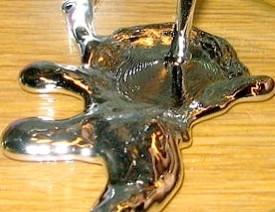
Quicksilver or Mercury
Rx: "Take of purified Quicksilver twenty-five Ounces; of Sulphur seven Ounces; stir the Quicksilver with the Sulphur melted, and if the Mixture takes fire, it is to be extinguished by covering the Vessel; then let the Matter be reduced to powder and sublimed [changed into a vapor and then cooled to form a concentrated solid from that vapor]."2
Description: Apothecary John Quincy says that this medicine is not used "in any Prescription, but rather design'd for the highest Purification of Mercury; as that which is receiv'd from it in the last Operation is preferable to any other for many Purposes."3
Physician Robert James provides a little better guidance to suggest why John Tweedy prepared this for the Revenge's medicine chest. "It is used in Fumigations [ships were sometimes fumigated to remove the 'bad air' that was believed to cause illness], against venereal Ulcers in the Nose, Mouth and throat, with little, and often with bad Success."4
It is unfortunate that more is not known of the Revenge surgeon Nicholas Holmes. Had his journal been published, we might have understood why he wanted this medicine in his chest.
1 "158. John Tweedy's Bill for Medicines. November 8, 1743". Privateering and Piracy in the Colonial Period Illustrative Documents, John Franklin Jameson, ed., p. 460; 2 John Quincy, Pharmacopoeia Officinalis & Extemporanea, 1719, p. 258; 3 Quincy, p. 259; 4 Robert James, Pharmacopoeia Universalis, 1747, p. 825
Colcothar
Listed in: Woodall: Cokethor (Dead-head)1
Category: Chemical Medicine
Photo: Wiki User BXXD - Burnt/Calcined Vitriol (Iron III Oxide)
Rx: Colcothar is identified by most physicians as being another name for Calcined or Burnt Vitriol. However sea surgeon John Woodall gives two different ways of creating colcothar (which he calls cokethor). The first is essentally the same method used to create Calcined Vitriol. The second is slightly different, however, which is why this has its own entry in the Sea Surgeon's Dispensatory.
Woodall thumbnail recipe for the first type of cokethor explains that it is gotten "from the feces [precipitate left after the creation] of Aqua fortis"2. Aqua Fortis is created by combining calcined or burnt vitriol with nitre (saltpeter)3. The precipitate would thus contain burnt vitriol, saltpeter and alum (which is part of creating Copperas).
Description: Woodall says that the first method of creating cokethor "is most in use amongst Surgeons, and indeed is most forcible, because therein is a great part of the fixed salt of Salt-peeter and of Allum mixed with the copperas"4.
Of this type of Cokethar, he explains it is "it is a medicine astringent [able to draw bodily tissue together] by reason of the copperas and alum, and abstersive [cleansing] by reason of the Salt-peeter, and therefore it is good for to prepare stubborne ulcers to a siccatrize [heal them over with a scar]."5
Although Woodall says this recipe is in great use amongst surgeons, It is unlikely that this would have been used by John Moyle or the surgeon of the Revenge since it is not mentioned by either of them.
1,2 John Woodall, the surgions mate, 1617, p. 285; 3 John Quincy, Pharmacopoeia Officinalis & Extemporanea, 1719, p. 278; 4 Woodall, p. 285-6; 5 Woodall, p. 286
Cremor Tartari (Cream of Tartar)
Listed in: Moyle: Cremor. Tarter1, Tweedy: Crem. Tart. Part. Pulv.2
Category: Chemical MedicineHumoral Property: cooling3; "pretty cooling"4
Photo: Wiki User ChamicalInterest - Cream of Tartar (Potassium Hydrogen Tartrate)
Rx: "Take any quantity of crude Tartar [Tartaric Acid], boil it in Water till the Parts which are capable of Solution be entirely dissolv'd; run the Liquour [liquid] whilst it is hot, through a flannel Bag into an earthen Pan, and evaporate till a Pellicle [thin film] appears: then set it in a cold place, and suffer it to stand quiet two or three days; afterwards decant [carefully pour off] the Liquor [kiquid], and there will be found Chrystals adhering to the side of the Pan; scrape them off, and evaporate the Liquor as before, and set it again to shoot into [produce] Chrystals; repeat the Evaporation till all the Chrystals are shot."5
Description: "It is a cooling gentle Cathartick, and passes off pretty much, as most saline Purgers do, by Urine. Its Dose is from {1/2 scruple to a scruple} dissolv'd in Broth."6
"[Both Cream of Tartar and Crystals of Tartar] may with very good Effect be given in small Doses as Alteratives [a medicine that makes changes in the body rather than purge it]. Their great Uses are, in Cases where there is a Tendency to an alcaline Putrefaction in the Primæ Viæ [first way – this probably refers to the humors], or whole Habit. ...Cremor Tartari is esteem'd a Specific [medicine of particular virtue] in the dry Gripes excited by the Fumes of Lead; a Distemper called the Bellon [lead poisoning], by smelters of Lead."6
1 John Moyle, The Sea Chirurgeon, 1693, p. 32; 2 "158. John Tweedy's Bill for Medicines. November 8, 1743". Privateering and Piracy in the Colonial Period Illustrative Documents, John Franklin Jameson, ed., p. 459; 3 John Quincy, Pharmacopoeia Officinalis & Extemporanea, 1719, p. 321; 4 Robert James, Pharmacopoeia Universalis, 1747, p. 784; 5 Quincy, p. 320-1; 5 Quincy, p. 321; 7 James, p. 784
Crocus Martis (Saffron of Iron)
Listed in: Woodall-Chest: Crocus Martis1, Moyle: Crocus Metallorum2
Category: Chemical Medicine

Rust
Rx: "Let thin Plates or Filings of Iron be expos’d to Air in dewy Nights, and Rain, until very rusty; then clear off the Rust, and do as before, until the whole is so changed: let it be rubb’d in the Mortar, and pass’d through a fine Seive.3
Description: "Crocus Martis. Safron of Iron – Good against disenterium [dysentery], Gonoreæ Diarrhæa, & generally all fluxes."4
"This is the most proper aperient [laxative] Preparation of all that are in use, because the Acids which are in most others make use of to dissolve the Iron, make it rather astringent [drawing together], especially in the Primæ Viæ [first way – this probably refers to the humoral qualities]."5
1 John Woodall, the surgions mate, 1639, Diagram opp. page 26; 2 John Moyle, The Sea Chirurgeon, 1693, p. 32; 3 John Quincy, Pharmacopoeia Officinalis & Extemporanea, 1719, p. 246; 4 John Woodall, the surgions mate, 1617, p. 320; 5 Quincy, p. 246
Flores Sulphuris (Flower of Sulfur)
Listed in: Tweedy: Flores Sulphur1
Category: Chemical Medicine

Photo: Wiki User Serpens - Flowers of Sulfur (Sulfur Powder)
Rx: "Take any quantity of Sulphur grossly powder'd, which put into a glass Body, and place in a small open Fire; and cover it with a Pot, or another Cucurbit [a vessel with a open necked top] turn'd upside down, so that the Neck of the one may enter the Neck of the other. Change the upper Cucurbit every half hour, fitting another in its place; add likewise new Sulphur. Gather the Flowers [residue of the sulphur from the heating process] which stick in the [upper, overturned] Cucurbit, and continue to do so, until there is as much as desired."2
Description: "They are used in Diseases of the Breast, and likewise in cutaneous [skin] Distempers both internally and externally. They are certainly both Balsamick [having restorative and curative properties] and Detersive [cleansing]... Every preparation from this Mineral is very effectual in lowering the Operation of Mercury by those particular Glands; and also gives great ease to those troubled with Hemorrhoids."3
"The Sulphur, by this Sublimation, is attenuated and purified; in other Respects it is not changed; but thus it becomes very fit for internal Medicinal Use: For when thus divided, it exerts its Virtues to a greater Advantage in the Body: and thus, also, it proves fitter for external Chirurgical [surgical] Uses, principally when it comes to be mixed with Balsams, Liniments, and Unguents."4
1 "158. John Tweedy's Bill for Medicines. November 8, 1743". Privateering and Piracy in the Colonial Period Illustrative Documents, John Franklin Jameson, ed., p. 460; 2 John Quincy, Pharmacopoeia Officinalis & Extemporanea, 1719, p. 315; 3 Quincy, p. 316; 4 Robert James, Pharmacopoeia Universalis, 1747, p. 807
Lapis Infernalis [Caustic Stone]
Listed in: Woodall-Chest: Lapis infernalis1
Category: Chemical Medicine
Photo: Wiki User TMV23 - Red Vitriol -
Cobalt (II) SulfateRx: "'Take capital Lees (i.e. the strongest Soap Lees ['Lees' are the dregs drawn from potash and lime.2]) any quantity; and evaporate to a dryness, and keep the Residue in a Glass well stopt. Or,
Lapis Infernalis alter[nate].
Take Vitriol calcin'd to a redness {3 ounces}, Sal Armoniack {1 ounce}, Tartar calcifi'd, and Quicklime, {of each 3 ounces}. Boil them in a sufficient quantity of Water, to make a strong Lixivum, which strain and evaporate to a dryness. The former of these [recipes] is preferable, is easiest to make, and most in use".4
Description: "Also the Causticke stone, called commonly Lapis Infernalis, is no other thing, then meerely a Vegetable salt [vegetable salts are extracted from the calcined ashes of a plant]".3 Caustic stones were used as potential cauteries to burn away unwanted flesh and sometimes to cauterize wounds to stop bleeding.
1 John Woodall, the surgions mate, 1617, p. 276; 2 "Soap", Encyclopedia Britannica, Fourth Edition, Vol XIX, p. 433; 3 Nicholas Culpeper, Pharmacopœia Londinesis, 1720, p. 478; 4 Woodall, p. 276
Lapis Medicamentosus (Medicinal Stone)
Listed in: Woodall-Chest: Lapis medicamitos1
-sulfate-heptahydrate_ben_mills.jpg)
Photo: ben Mmills
Green Vitriol - Iron(II) Sulfate
Category: Chemical Medicine
Rx: "Lapis Medicamentosus, the medicinal Stone, a Composition of green and white Vitriol, Alum, Anatron of Sandiver [saltpeter], common Salt, and Salt of Tartar [potassium carbonate], melted over the Fire, and stirr'd till they thicken; then mix'd with Powder of Venice [Turpentine], Ceruss [white lead - lead carbonate], and Armenian Bole, stirring the whole till it grows hard."2
Uses: Woodall promises to explain what this is, but never gets around to actually doing so. He recommends it for treating putrefied [rotten] gums when the patient has scurvy."3 Ephraim Chambers says in his Cyclopedia, "This is said to fasten the Teeth, preserve the Gums, heal and dry up Ulcers and Wounds , and is used in Injections [into open wounds, not into the skin], and in Compositions for sore Eyes."4
1 John Woodall, the surgions mate, 1617, p. 191; 2 Ephraim Chambers, Cyclopedia, Vol. 1, 1728, p. 431; 3 Woodall, p. 191; 4 Chambers, p. 431
Lixivium (Lye)
Listed in: Woodall: Lixivium Commune1
Category: Chemical Medicine
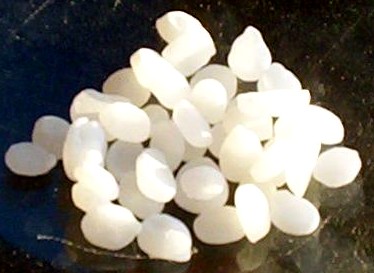
Photo: Wiki user Walkerma - Lixivium (Sodum Hydroxide) Pellets
Rx: "...good strong Lixivium [is] made with fresh water & ashes till it be slippery, namely, let the water be made seething hot ere the ashes be put in, adding if they be ready, or may be had in the shippe these hearbes following: St. Johns wort, wormewood, centaury, rosemary, sage, chamomile & mellilote flowers, or at the least some of them, also you may adde Lupines thereto: but howsoever though there be no hearbes: adde salt good store when it is cleared, but not before, and then though you have neither hearbes nor lupines, it will bee of good force, for it is the salt vegetable in the ashes, which is the best healer, the next best is the mineral or sea-salt"2.
Description: "...there is an ordinary Lixivium, made by expert Chirurgions, for the healing of Ulcers, which is Mundificative [cleansing], Abstersive [cleansing], Discussive [dispersing], and very Sanative [cleansing], performing much in Chirurgery, the chiefe ingrediences whereof is vegetable and mineral salts made by decoction with vulnerary [healing] herbes in fair water to a just consistence: this Lixivium in Tumors, Ulcers, Fractures, Dislocations, as also in great Contusions, Obstructions, Gangrenes, and many other like infirmities, is a most sure and ready medicine"3.
1 John Woodall, the surgions mate, 1617, p. 63; 2 Woodall, p. 163; 3 Woodall, p. 276
Lixivium Forte
Listed in: Woodall-Chest: Causticke liquid1
Category: Chemical Medicine
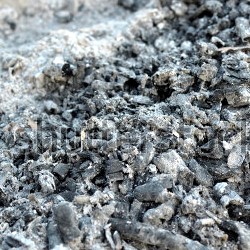
Wood Ashes
Rx: Jacques Guillemeau gives a procedure for making "goode Lixivye, onlye of Oacken ashes, or of Ashes of Vinebranches, whe[n] as the same is wel sodde[n] with potashes [potassium carbonate], and of Beanestrawe, addinge therunto a little unslissed [unslaked] lime [calcium oxide or quicklime], whereof we may make verye excellent good Cautereyes."2
Woodall gives more detail on how to prepare what he uses in his book. "The causticke stone if you boile it to a just consistence and having put it out, being yet warme, smooth it over with an iron splatter, then with a knife cut it into pieces, you shall have it ready to make incision after your owne will, for any causticke laid on an Aposteme may spread further and broader then thy will to the damage of the Patient, but this kinde of causticke you may hold in your hand wrapped in some cloute [small piece of thick lint] or piece of plaster spread, and so you may rule it at your owne desire, and yet it marketh greater spread with lesse paine then the other."3
Description: Woodall also uses Lixivium as a potential cautery to burn off unwanted skin.4 "This is to be understood Capitall lees ['Lees' are the dregs drawn from potash and lime.5], a very necessarie medicine to be at hand in the Surgeons chest, to molifie [soften] the liquid or white causticke when it groweth dry ...the liquid causticke is made only of unslaked lime and strong Capitall lees by decoction together to the thicknesse of an unguent, and when occasion of application thereof is, lay on the griefe a minium [red lead] or some other cleaving Emplaster with a hole cut therein, so bigge as there shall be occasion to make an orifice, and thicke spread the white causticke thereon, & let it remaine thereon at the least two houres, having a care so to defend the same that it doe not spread [and burn other areas of the skin]."6
1 John Woodall, the surgions mate, 1617, p. 63; 2 Jacques Guillemeau, The French Chirurgerie, p. 42; 3,4 Woodall, p. 63
Lixivium Fortis
Listed in: Moyle-Composition: Lixivium Fortis1
Category: Chemical Medicine

Wood Ashes
Rx: "Herbæ Fomentatio prædict. [Fomentationibus Herbs previously mentioned - the receipt includes a handful of herbs such as Hypericum. Centaury, Absynth, Rosin and Bayberry], decoct [pour] them in a Lye made strong with Wood ashes {10 pounds}, strain and add Spir. Vin. com. [common Spirit Vini - Brandy] {2 pounds}, Bay Salt {2 ounces} misce f. Lixivium [mix to make a Lixivium]"2.
Description: "[I]n case of Mortification [gangrene], [this is] the best and strongest Lixivium"3. He also advises that it is "to be applyed hot with stupes [pieces of folded cloth]."4
Although he doesn't completely spell it out, Moyle is suggesting the use of his Lixivium Fortis as a cauterizing agent to burn away gangrenous skin. While this serves the same purpose as Woodall's Lixivium Forte, Moyle's recipe is a bit more specific and complex than Woodall's, which is why it is included as its own entry.
1,2,3,4 John Moyle, The Sea Chirurgeon, 1693, p. 18
Mel Vitriol
Listed in: Woodall: Mel Vitrioli1
-sulfate-heptahydrate_ben_mills.jpg)
Photo: Ben Mills - Copperas (IIron II Sulfate)
Category: Chemical Medicine
Rx: "...it is made of calcined Vitriol infused [soaked] in spirit of wine, and the tincture of coperas [Copperas - Iron II Sulfate] thereby drawen out, and then the spirit of wine evaporated per B.M. [bain marie - a double boiler for distilling chemicals]"2.
Description: "This Liquor [liquid], or rather honey prepared from Coperas, so called, because it is in thicknes and colour not unlike honey; It is an excellent remedie against any lachrimous or weeping ulcers, or fistula's, to stay defluxions [flows] of humours in them, for it is very astringent [able to draw the body's tissues together], and doth well fortifie a weake member... it is excellent for to cure rotten gums or any putred or corrasive ulcers of the throat or mouth, or elsewhere, and hath many other speciall vertues"3.
1,2,3 John Woodall, the surgions mate, 1617, p. 285
Mercurius Precipitate Ruber (Red Mercuric Precipitate)
Listed in: Woodall-Chest: Præcipitate1
Category: Chemical Medicine
_oxide.jpg)
Red Mercuric (II) Oxide
Rx: "'Take crude Mercury {1 pound} Aqua Fortis [Nitric Acid in Water] {2 pounds} let these stand in the heat of Ashes, in an open upright Glass, shaped like the Hungary-water Phials, until the Flowers [a residue from the distilling that collects on the neck of a retort] begin to appear, and the Mercury seems all dissolv'd into a white Mass: then gradually encrease the Fire to the third degree2 and so keep it until it turns of a deep red; then take it away; let it cool, and break the Phial to get out the Precipitate, which will look of a most beautiful bright Colour.'"3
Description: "Mercurius Precipitatus is very good to further digestion [causing the formation of new, healthy flesh] in ulcers evill disposed, and to dispose them to better healing, by cleaning and digesting them, and because it is Mercury or Quick-silver"4.
"This is rarely given inwardly but by Empiricks [people with little or no formal training] and ignorant bold Persons. It is a good Escharatick [caustic medicine or potential cautery], and much us'd amongst the Surgeons for that purpose in Basilicon, and other Dressings. It is also in Unguents for the Itch [a scabies mite infection], and other cutaneous Foulnesses, but is to be us'd with Caution."5
John Woodall, the surgions mate, 1617, p. 115; 2 "To make a Fire of the First Degree, two or three coals lighted will suffice to raise a most gentle heat. For the Fire of the second degree, three or four coals will serve, to give such a heat as is able senisibly to warm the Vessel, but so as a hand may be able to endure it for some time. For the Fire of the Third degree, you must cause heat enough to make a Pot boil, that is fill'd with five or six quarts of water. For the Fourth Degree, you must use Coals and Wood together, enough to give the most extream heat of all.", From Nicholas Lémery and Walter Harris, A course of chemistry, 1686, p. 38-9; 3 John Quincy, Pharmacopoeia Officinalis & Extemporanea, 1719, p. 259; 4 Woodall, p. 115; 5 Quincy, p. 259
Mercurius Sublimatus (White Mercury Sublimate)
Listed in: Woodall-Chest: Mercurim Sublimatus1
Category: Chemical Medicine
Photo: Wiki User Leiem - Mercury Sublimate
Rx: "'Take a Pound of Quicksilver, which dissolve in strong Aqua Fortis [Nitric Acid in water]; pour off as much afterwards as will run off clear, and with a gentle heat evaporate the white Mass to dryness. Put this powder in a Glass Mortar, and mix with it a Pound of calcin'd Vitriol, as much decrepitated [roasted unto cracking] Salt; put them together into a Matrass [a vessel with a long neck], whose two thirds remain empty: place it in Sand [a sand furnace - which heats a container of sand in which the vessel is placed], and begin with a small Fire, which continue three Hours; then increase it to a pretty good Strength, and the Sublimate will arise to the top.'"2
Description: "Mercurim sublimatus, made of Argentum vinum [quicksilver], is excellent against the Morbus Gallicus [syphilis], this medicine truly prepared, is a Laxative, a Diaphoretice [diaphoretic - a drug causing perspiration], and Diauretitice [diuretic - causing urine], a vomitive, and the best and worst corasive [corrosive] medicine that can be devised."3
"This Sublimate is a violent Escarotick [caustic medicine or potential cautery], and eats away proud Flesh: half a Dram of it dissolv'd in a Pound of Lime-water, turns it yellow; and is call'd Phagadenick Water, which is us'd to wash Ulcers, and some tetterous [skin disease] Eruptions."4
1 John Woodall, the surgions mate, 1617, p. 115; 2 John Quincy, Pharmacopoeia Officinalis & Extemporanea, 1719, p. 255; 3 Woodall, p. 115; 4 Quincy, p. 255
Mercurius Sublimatus Dulcis (Sweet Mercury Sublimate)
Listed in: Moyle: Mercury dulc.1
Category: Chemical Medicine
Photo: Wiki User Leiem - Mercury Sublimate
Rx: "Take of the above corrosive Sublimate one Pound, crude Mercury twelve Ounces: grind them in a Glass or Marble Mortar until no Quick-Silver appears; then fill one third of a Bolt-Head [a flask with a long neck] with it. Set it in a Sand Furnace [a container of sand heated on a furnace]; let the Sand lie half an Inch thick between the bottom of the Bolt-head and the Kettle, filling it up with Sand within an Inch of the Neck: stop the Mouth of the Glass with a little Paper, or Cotton-Wool; then give a gentle Fire about two Hours; encrease it for about three Hours, and then make it very strong for as much longer. When it is cold, break the Glass over a clean Sheet of Paper, and separate the Sublimate from the light Flowers [the residue the collects from the heating process] at the top, and the Dust which lies at the bottom. Powder it again, and repeat the Sublimation after the same manner to the third time."2
Description: "This is given to young Children from {2 to 8 grains} and to grown Persons to {1 scruple}. It is reckon'd very effectual against Worms in Children; and purges those slimy Humours, whence arise [in] so many of their Disorders."3
Apothecary John Quincy goes on to give a rather convoluted explanation how the process of sublimating the caustic Mercury Sublimate with crude Mercury makes it not only "a very safe, but in many cases a noble Medicine. ...Thus a violent Poison is mitigated into a Vomit or Purge; nay, it may easily happen (especially in robust Constitutions... the difference between Mercury corrosive [sublimate] and dulcify'd, lies in a greater and lesser degree of Operation and Force"5.
1 John Moyle, The Sea Chirurgeon, 1693, p. 32; 2,3 John Quincy, Pharmacopoeia Officinalis & Extemporanea, 1719, p. 255; 4 Quincy, p. 256; 5 Quincy, p. 257
Mercurius Vitæ
Listed in: Moyle: Mercury Vitæ1
Category: Chemical Medicine

Photo: Aram Dulyan - Antimony
Rx: "Let the Butter, just now describ'd [Cinnabar Antimonii], be melted, either by exposing it to the Air, or a gentle Heat: put it into a clean Retort [a closed vessel with an outlet tube]; set it in a Sand Furnace [a furnace that heats a container of sand in which the vessels are set]; and by a Fire of the second degree2, distil it: the Butter will be made more white and pure; and by this Rectification [repeated distillation] be separated from some dirty Fæces, which will remain in the bottom of the Retort. Melt all the rectify'd Butter into the Receiver [receiving vessel], and put to it warm Fountain Water [spring water]; stir it well with a clean Stick: when 'tis settled, pour off by Inclination [inclining], and keep the first by it self. Put on more Water, stir, and let it settle; and so do till the Powder is freed from all saltish Taste; then dry it gently, and keep it for use."3
Description: "It's Virtues are the same with the Flowers of Antimony; by Dose from {2 to 8 Grains}."4
The Virtues of Flowers of Antimony: "...its Operation [is] very violent, chiefly by Vomit. It is an excellent Medicine in Maniacks, who can bear its Violence; and is the Herculean Remedy, by which some have got such great Reputation in those Cases"5.
1 John Moyle, The Sea Chirurgeon, 1693, p. 32; 2 "To make a Fire of the First Degree, two or three coals lighted will suffice to raise a most gentle heat. For the Fire of the second degree, three or four coals will serve, to give such a heat as is able senisibly to warm the Vessel, but so as a hand may be able to endure it for some time. For the Fire of the Third degree, you must cause heat enough to make a Pot boil, that is fill'd with five or six quarts of water. For the Fourth Degree, you must use Coals and Wood together, enough to give the most extream heat of all.", From Nicholas Lémery and Walter Harris, A course of chemistry, 1686, p. 38-9; 3,4 John Quincy, Pharmacopoeia Officinalis & Extemporanea, 1719, p. 271; 5 Quincy, p. 268
Minium (Red Lead)
Listed in: Woodall: Minium1
Category: Chemical Medicine
Humoral Property: "of a drying nature"2
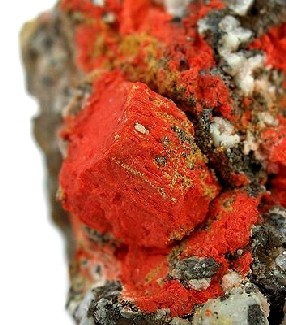
Photo: Rob Lavinsky - Naturally Occuring Minium
Rx: "‘This is made by melting Lead in an earthen unglazed Pan, and stirring it over the fire, till it is reduc’d to a Powder; then it is call’d calcined Lead. But when this is put into a reverberatory Fire [a reverberatory furnace isolates the material being processed from contact with the fuel, but not from contact with combustion gases] for three or four hours, it will turn red, and is then Minium.’"3
Minium also occurs naturally, being "found in silver Mynes, acquiring the fair rubetude [redness] by artificial and reiterated washing; so that according to Pliny [Gaius Plinius Secundus or Pliny the Elder, Roman naturalist], one Minium is differenced from another, only by washing and art"4.
Description: "Minium, binds... used in Unguents and Emplasters."5
Physician Robert James says that Minium or Red Lead has the same medicinal value as Ceruse (White Lead).6 "This Ceruse is of Use in watery, ulcerous, running Sores, or Diseases of the Skin, being sprinkled thereon. If this fine Powder be drawn along with Breath into the Lungs, it causes a violent, and almost incurable or mortal Asthma. If received into the Mouth, and swallowed along with the Spittle, it occasions inveterate Distempers in the Viscera [internal organs], intolerable Faintings, Weaknesses, Pains, Obstructions, and, at last, Death itself. ...Let all, therefore, beware of this Poison, which being both without Smell and Taste, proves more pernicious, as it is the less discovered, and does not shew itself till it had destroyed the Body."7
1 John Woodall, the surgions mate, 1617, p. 113; 2,3 John Quincy, Pharmacopoeia Officinalis & Extemporanea, 1719, p. 251; 4 Jean de Renou, A Medicinal Dispensatory, 1657, p. 409; 5 Thomas Brugis, The Marrow of Physick, 1669, p. 171; 6 Robert James, Pharmacopoeia Universalis, 1747, p. 812; 7 James, p. 812-3
Oleum Absinth Chymice (Chemical Oil of Wormwood)
Listed in: Woodall: Oleum Absinthy Chymice1
Category: Chemical Medicine
Photo: H. Zell - Absinthi Artemisia Absinthium
Rx: "Take of dry Wormwood a pound, spring water 20 pound, steep them twenty four hours, and distil them in a great Alembick [chemical still], with his Refragitory [Refrigeratory - a vessel filled with cold water surrounding the spout of the alembic, causing vapour to condense], or a Copper one with a worm. Let Oyl be separated from the water with a Funnel, or separating Glass as they call it, and let the water be kept for another Distilation. Let two or three of the first pounds of water be kept for the Physitians use, both in this and other Chymical Oils drawn with water."2
Description: "Oyle of worme-wood is good for the stomacke to strengthen it, to stay vomiting, to kill worms, asswageth the paine of the teeth, and is used in agues [fevers, usually malarial]."3
"[For the virtues of chemical oils like Oleum Abinsth] see the virtues of the Herbs themselves."4 Of absinth or wormwood, physician Nicolas Culpeper says it will "help weakness of the stomach, cleanse Choler [yellow bile, one of the bodily humors], kill worms, open stoppings [usually of the digestive system], help Surfeits [referring to problems with digestion due to overindulgence], clear the Sight, resist poyson, cleanse the Blood [another bodily humor], and secure cloaths from moths."5
1 John Woodall, the surgions mate, 1617, p. 77; 2 Nicholas Culpeper, Pharmacopœia Londinesis, 1720, p. 254; 3 Woodall, p. 77; 4 Culpeper, p. 255; 5 Culpeper, p. 17
Oleum Antimony (Oil Or Butter of Antimony)
Listed in: Woodall: Oleum Antimony1
Category: Chemical Medicine
Photo: Wiki User Leiem - Butter of Antimony (Antimony Trichloride)
Rx: "Take of crude Antimony, Mercury sublimate, of each one pound, beat them to powder, and put them in a glass retort [closed vessel with a long stem], with a large Neck, give fire by degrees into a Reverberatory [a furnace that isolates the material being processed from contact with the fuel, but not from contact with combustion gases] or else in sand [a sand furnace, which heats a container of sand into which the vessel to be heated is set], the Fat will distil down into the receiver [receiving vessel], that part of that which sticks to the Neck of the receiver, will easily be melted, by putting a gentle fire under it; let this Fat be rectified [purified through repeated distillation] in a small Retort, and keep either in an open Vial, or in a Cellar or other moist place, that it may be dissolved into Oyl, which shall be kept in a vessel close stopped."2
Description: "Oyle of Antimonie or Stibium is good for them that have convulsions, or any astonishing disease, or other evill affections of the braine, foure graines thereof drunke, it asswageth the paine of the gowt [gout] and collicke, cureth feavers, helpeth the bladder ulcerated, and wonderfully helpeth the canker [cancer], Fistula phagedena [cutaneous ulcers that spread rapidly], the fretting [gnawing] or eating pockes [pustules, probably referring here to smallpox], the wolfe [voracious ulcers], and all other sorts of ulcers."3
1 John Woodall, the surgions mate, 1617, p. 77; 2 Nicholas Culpeper, Pharmacopœia Londinesis, 1720, p. 258; 3 Woodall, p. 77
Oleum Lateritium (Oil of Bricks)
Listed in: Woodall: Oleum Philosophorum1
Category: Chemical Medicine
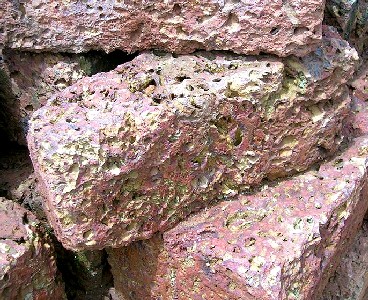
Photo: Wiki User Shyamal - Laterite Bricks
Rx: "Oil of Bricks – ‘Let Bricks, heated red-hot, be plung’d into Olive Oil, till the whole Oil is imbibed; then let the Bricks being sufficiently broke, are to be put into a Retort [closed container with a neck on the side for distilling]; and by a Sand-heat [sand furnace that heats a container of sand in which the retort is set] the Oil will ascend with a Spirit, which is to be separated from the Oil."2
Description: "Oyle of Philosophers, or of tile-stones or bricke-bats [pieces of bricks], the eldest is best, very like it is to Oleum Petreoleum in vertue it doth extenuate and penetrate upward, digesteth and consumeth all excrementall matter: and is profitable for colde affections of the spleene, reines [kidneys], bladder, nerves, wombe and joynts, for the Lethargie, Apoplexie [unconsciousness caused by hemorrhage or stroke] and falling sicknesse [epilepsy], and many other the like griefes."3
"The Author of the Pharmacopœia Reformata tells us, that this Preparation has had a Place in most Dispensatories, under the pompous Names of Oleum Philosophorum, Oleum Sanctum, Divinum, Benedicturm; but whatsoever Opinion some may have of this Preparation, it is a very indifferent, as well as disagreeable one, and is rarely used for medicinal Purposes; and it is probable, that, for these Reason, the Edinburgh Dispensatory has rejected it. The Liquor which comes over along with this Oil in Distillation, is improperly called Spirit, being really no more than Phlegm, or Water tainted with the empyreumatical [decomposed, burnt matter] Taste of the Oil.”4
1 John Woodall, the surgions mate, 1617, p. 75; 2 Robert James, Pharmacopoeia Universalis, 1747, p. 770; 3 Woodall, p. 75; 4 James, p. 770-1
Oleum Succini (Oil of Amber)
Listed in: Woodall-Chest: Oleum Succini1, Moyle: Oleum Succini2, Tweedy: Oleum Succini3
Category: Chemical Medicine
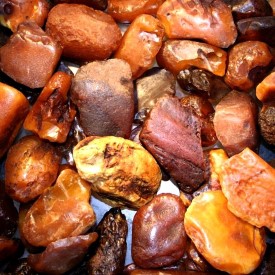
Photo: Wiki User Anzi - Unpolished Amber
Rx: "Take of yellow Amber part, burnt flints, or powder of Tiles two pounds, distil them in a Retort [closed distilling vessel with a stem on the side] in Sand [sand furnace - a container of sand heated by a furnace where the retort is placed] keep the white clear Oyl, which comes out first by it self then distil it on, till all come out keep both Oyls severally [separately], and rectifie [correct through repeated distilling] them with water gather the Salt Amber which sticks to the neck of the Retort and being purged by Solution Filtration [filtering out a substance by bathing it in a solution], and Coagulation [precipitating the solid out of the solution], according to Art, keep it for use."4
Description: "Oyle of Amber helpeth the paine in the head, resolution of the sinewes and falling evill [epilepsy], one drop or two taken with water of Betony or Lavender, or in faire water [spring water], it preserveth also from poyson, and mixed with parsly water or malmesie [malmsey, a strong, sweet wine], is a singular remedy in discussing diseases of the reines [kidneys] and bladder, bringing foorth the [bladder or urinary tract] stone, and opening the passages of urine, it profitteth in the collicke & strangullion [inflammation and swelling in the throat]. A drop put into a little verbene water [made from the plant verbena], and so given to a woman in travel, it refresheth all the weake faculties of the body, consumeth humours, confirmeth and openeth the braine."5
1 John Woodall, the surgions mate, 1617, p. 77; 2 John Moyle, The Sea Chirurgeon, 1693, p. 34; 3 "158. John Tweedy's Bill for Medicines. November 8, 1743". Privateering and Piracy in the Colonial Period Illustrative Documents, John Franklin Jameson, ed., p. 457; 4 Nicholas Culpeper, Pharmacopœia Londinesis, 1720, p. 257; 5 Woodall, p. 77
Oleum Sulphuris per Campanam (Oil of Sulphur by the Bell)
Listed in: Woodall: Oleum Sulphuris per Campanam1, Moyle: Oleum Sulph. Per Campanum2
Category: Chemical Medicine
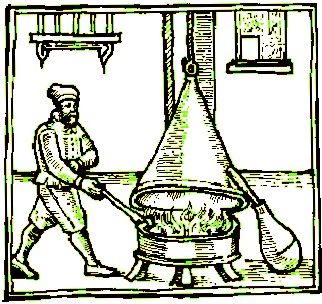
Bell (Campanam) Still For Making This Oil, From
The Art of Distilling, Book 3,
By John French (1651)
Rx: "It is prepared in a Bell Still by copious burning and consuming of Brimstone, by which a sharp span [period of time] heating against the sides of the Still, will turn into Liquor [liquid], and flow down like water of Oyl; the orderly disposing of the Sand and Brimstone and other commodities belonging to the operation we leave to the ingenuity of the Artificer."3
Description: "Oyle of Sulphur made from the humid vapors therof, is good to make teeth white, to take away the morphew [skin blemishes], cureth venereal ulcers, expelleth diseases arising from winde or colde, is good against the falling sicknesse [epilepsy], shortnesse of breath, evill affections of the lungs, and easeth the tooth-ach, and is, being well prepared, a true cordiall medicine [good for the heart]."4
"It prevails against diseases coming of Cold, Putrifaction, or Wind, Feavers, Agues Tertian [malarial fever recurring every two days] or Quotidian [malarial fever recuring every three days] , Pestilence Wound and Ulcers, affects of the Brain, Mouth, Teeth, Liver, Stomach, Spleen Matrix [Womb] and Bladder, Entrals and Artery, coming of abundance of Humours or Putrifaction, outwardly applied it helps Fistulaes, Ulcers of the Mouth, and Gangrenes."5
1 John Woodall, the surgions mate, 1617, p. 75; 2 John Moyle, The Sea Chirurgeon, 1693, p. 34; 3 Nicholas Culpeper, Pharmacopœia Londinesis, 1720, p. 259; 4 Woodall, p. 75; 5 Culpeper, p. 259
Oleum Terebinthina (Oil of Turpentine)
Listed in: Woodall-Chest: Oleum Terebinthina1, Moyle: [Oleum] Terebinthinie2, Tweedy: Oleum Terebinth.3
Category: Chemical Medicine
Photo: Wiki User Antramir - Collecting Turpentine
Rx: "Take of Venice Turpentine as much as you will, put it into an Alembick [alchemical still] with four time its weight in common water, still it with a convenient fire, and draw off a white thin Oly like water, the Colophonia [translucent resin] will remain in the bottom of the Vessels, and this Oyl may be drawn into a Bath, more aptly from burning in a Glass."4
Description: "Oyle of Terebentine is taken inwardly for shortnesse of breath, the tysicke [tisic - cough], against the [bladder or urinary tract] stone, the collicke colde and windy affections of the bre[a]st: it is outwardly used for to heale sinewes wounded, or troubled with any intemperature, also to fill ulcers with flesh, and knit them up leaving no siccatrize [cicatrize - scar] in them."5
"It is wonderful good in cold afflictions of the Nerves, and all Diseases coming of cold and wind: it corrects the cold afflictions of the Lungs; as Asthimes[asthmas] and difficulty of Breathing &c. A dram being taken in the morning; outwardly it adorns the body, and takes away the parts of Scabs, and the Small Pox, and Chaps [roughness or soreness] in the Skin and Breasts of Women, and Deafness, being dropped into the Ears."6
1 John Woodall, the surgions mate, 1617, p. 76; 2 John Moyle, The Sea Chirurgeon, 1693, p. 34; 3 "158. John Tweedy's Bill for Medicines. November 8, 1743". Privateering and Piracy in the Colonial Period Illustrative Documents, John Franklin Jameson, ed., p. 457; 4 Nicholas Culpeper, Pharmacopœia Londinesis, 1720, p. 256; 5 Woodall, p. 76; 6 Culpeper, p. 457
Oleum Vitrioli (Oil of Vitriol - Sulfuric Acid)
Listed in: Woodall-Chest: Oleum Vitrioli1, Moyle: Oleum Vitriol2
Category: Chemical Medicine
Humoral Property: "exceeding hot and colde"3
Photo: Wiki User Toxic Walker - Sulfuric Acid on a Piece of Towel
Rx: "The weak and strong Spirit of Vitriol, also the Colcothar Vitriol, first calcined, is to be distilled in earthen vessels for three days without intermission, in a reverberatory head; the liquor drove off being distilled over again in a glass retort with a sand heat [sand furnace - a container of sand heated by a furnace], the weak spirit will ascend, the strong remaining behind, which is usually, though improperly, called oil of vitriol. What remains in the earthen vessels after the first distillation, is called the cocothar of vitriol."4
Description: "Oyle of Vitriole is ...mixed in waters, decoctions, sirupes or conserves, maketh them in taste tart or sowerish, and in colour purple like, delighting them that are sicke of feavers, freeth obstructions, recreateth the bowels: and is very effectuall in the pestilence, falling sicknesse [epilepsy], palsie and stopping of urine".5
"[It] Comforteth the Stomach after a wonderful manner, and stirreth up the Appetite. It defendeth the whole Body from Apostemes and Inflammations, and therefore it is used with good success in the Pluresie [tuberculosis], and also in vulnerary [healing] Drinks it is approved good. It helpeth the infirmities of the Lungs, taken with Water of Fennel or Fumitory. It cutteth away the melancholy humors [black bile, one of the bodily humors] from the Stomach, being taken with Balm-water. It consumeth Phegm [another bodily humor], cures the Colick, and the Loosness of the Belly. It quencheth
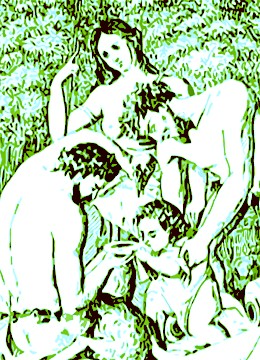
Artist: Guisseppe Garzola
The Goddess Panacea Helping the Sick (1716)
Panaceas were Medicine Believed to Be
Useful in Any and All Health Problems
the thirst in Fevers, cures the Hicock hiccups], and Loathing of Meat. It attenuateth the Blood [a third bodily humor], defendeth wounded parts grieved from fear of Gangrene, or Putrefaction of the Blood. It conglutinateth Ruptures as well of Bones and Veins; and doth exceedingly comfort and corroborate [strengthen] all parts of Man's Body, and may well be numbred as a principal amongst cordial Medicines [medicines for the heart]. It is also a very good Medicine, not only in preventing the Scurvy, taken inwardly, but also in the Cure of the Scurvy many ways; both inwardly taken with any comfortable Wine, or with Beer for need, or to make a Beverage therewith; and daily to use it in small quantity, namely, four drops for a Dose. In the Calenture [tropical fever accompanied with delirium], it excelleth all other Medicines, taken in Plantan, Sorrel, or any other Water, or only in fair Water [spring water]: It is good to rub foul black Teeth, to make them clean and white, but use it not often, for then it will consume them. In Ulcerations of the Mouth, Throat, or Uvula, that resist ordinary medicines, touch the ulcerated part but once with this Oil, and the Ulcerations will heal very fast afterwards with any ordinary medicines and helps, remembring, as cause shall require, to use due Evacuations [purging the body using emetics, enemas, diuretics and laxatives], or Phlebotomy [blood letting]. It is good in the Squinancy or Angina, used certain drops in a fit Gargarism or Lotion, namely, to make it somewhat sowre, and then gargarize warm
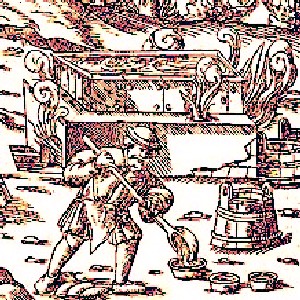
Artist: Peter Schmidt - Recovery of Vitroil (1580)
therewith; for it mightily quencheth Inflammations, and tempereth well the Blood; and being likewise a ittle thereof given to a drink, namely, six drops, in such a case it is much the better; always remembring that in all such Diseases you cause Loosness of the Belly, and sometimes Phlebotomy. Moreover, in Ulcers and Fistula's, scarce a better Medicine is found to inlarge a strict [contracted] Orifice, remove a callus, or to prepare an inveterate Ulcer to good healing, only by touching it with Lint on the end of a Probe, thereby putting the Medicine on that place where the Disease is. It is a good corrective in all purging Medicines, and helpeth them to do their office; for it comforteth the whole Body, and giveth a grateful taste almost to any Medicine. It is also good to a weak Stomach oppressed with phlegm or slime, and helpeth Appetite, taken in Conserve of Roses. There is no Medicine more precious in pestilential Fevers. The true and utmost Dose may well be taken according to discretion and judgment: But note this, That if you put any of it into any liquid Medicine, as Barly-water, Juleps, or such like, which you intend to divide in several Doses, let the Glass be always shaken well before your pour it out, else the Oil will lie at the bottom, and make the last Dose not only too sharp if taken, but also Dangerous."6
1 John Woodall, the surgions mate, 1617, p. 74; 2 John Moyle, The Sea Chirurgeon, 1693, p. 34; 3 Woodall, p. 74; 4 Henry Pemberton, Dispensatory of the Royal College of Physicians, 1747, p. 146-7; 5 Woodall, p. 74; 6 Thomas Brugis, The Marrow of Physick, 1669, p. 50-2
Plumbum Ustum (Burnt Lead)
Listed in: Woodall: Plumbum Ustum1
Category: Chemical Medicine
Humoral Property: "of a drying nature"2
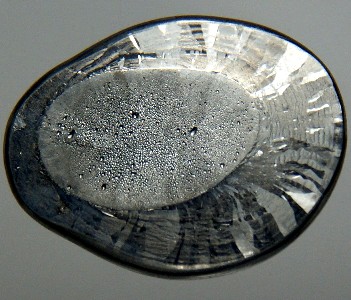
Photo: Wiki User MaterialScientist - Freshly Solidified Pure Lead
Rx: "Take two parts of Lead, and one of Sulphur, and set the Sulphur on fire; when it is burn’d away, it will leave the other in a black powder."3
"Lead may be burned after divers manners: but before ustion [burning], it is for the most part attenuated [its forcefulness is reduced] by filing or slicing; then put into a new earthen pot, and so to be burned, Sulphur being mixed with it, till it may easily be pulverated [powdered]. Now this Sulphur must be interjoyned with the plates or slices [of lead], and so both inflamed together, and stirred with an iron spatula. In the interim, beware lest the most noxious exhalation of the Lead pierce the nostrils, for it greatly hurts the brain... it offends the nerves, and often causes stupidity, and the Palsey to such especially as work much in Lead."4
Description: "[Plumbum Ustem] Is astringent, filleth up wounds, eateth away their excrescences, stayeth the rheume [fluid discharge] of the eyes, blood, and is profitable against the ulcers of the fundament [anus], hemorrhoids, and their inflammations."5
1 John Woodall, the surgions mate, 1617, p. 113; 2,3 John Quincy, Pharmacopoeia Officinalis & Extemporanea, 1719, p. 251; 4 Jean de Renou, A Medicinal Dispensatory, 1657, p. 68; 5 Woodall, p. 113
Resina Jallapæ (Resin of Jalap)
Listed in: Tweedy: Resin. Jalap.3
Category: Chemical Medicine
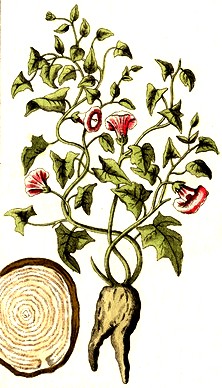
Jalap (Ipomoea Purga), From Convolvulus
Mechoacanna by Johannes Zorn (1796)
Rx: "'Take of select (that is what is blackest, most heavy and sound) Jalap powder'd {1 pound} put to it of rectify'd Spirit of Wine {4 pounds} invert a Bolt-head [vessel with a long neck], and lute [seal with clay or similar substance] it; set it upon warm Sand three or four Days, and shake it every Day two or three times: when the Spirit is well ting'd, decant [pour] it carefully through a Hair Sieve into a Cucurbit [a vessel with a large, open top]; set it in a gentle Heat of Sand, and draw off the Spirit of Wine to one Pint, which may be return'd upon the Jalap to make a second Extraction: decant the Spirit as formerly; lute on its Head [a retort for distilling] and Receiver, and distil as before. Let all cool, and in the Curcubit there will be a Resin in the form of Turpentine; which wash in three or four Waters, and in a gentle Heat dry it, till it will beat into Powder.'"2
Description: "The Virtues are the same as those of the Root, ...but it works rougher, because all such Substances stick to and hang upon the Coats of the Stomach and Intestines, so as to be the Authors of a great deal of Pain and Uneasiness; and for this reason, this is corrected with Sugar, Cream of Tartar, or such like things, whereby it is brought into the same state as Nature presented it to us first in the Root. ...Its Dose from {3 grains to a scruple}"3
Of Jalap, apothecary John Quincy says, "[French apothecary Simon Boulduc] says it is one of the best Catharticks [purging medicines] we have. He has found it so by Experience, and wonders that it is so little us'd at present: for as it is so gentle that it stands in need of no Corrector [additional medicine used to dampen the violence of its purging effect]... [The powder] was very Diuretick, as he experienced in many Hydropsical Cases [edemas]: that the Residue which yet contain'd a little of what was resinous, purg'd reasonably, but with Gripings [pains in the stomach and intestines] ...it's griping Quality may be commonly corrected by fix'd Salts, or Loaf-Sugar."5
1 "158. John Tweedy's Bill for Medicines. November 8, 1743". Privateering and Piracy in the Colonial Period Illustrative Documents, John Franklin Jameson, ed., p. 459; 2 John Quincy, Pharmacopoeia Officinalis & Extemporanea, 1719, p. 303; 3,4 Quincy, 304; 5 Quincy, 192-4
Saccharum Saturni (Sugar of Lead)
Listed in: Tweedy: Sach. Saturn.1
Category: Chemical Medicine
Humoral Property: dry2
Rx: "Saccharum Saturni, Salt or Sugar of Lead.
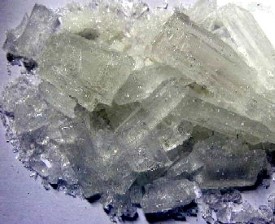
Photo: Wiki User DormroomChemist
Sugar of Lead (Lead II Acetate)
'Take of three or four Pound of any of the above-mention'd Preparations [includomg Minium or Red Lead, Cerussa or White Lead and Plumbum Ustem or Burnt Lead] ... powder it, and put it into a large Glass or earthen Vessel: pour upon it distill'd Vinegar four fingers high; set it in Digestion [heat it to extract essential components], in hot Sand, for two or three days, stirring about the Matter every now and then: let it at last settle, and pour off the Liquor [liquid] by Inclination [inclining the vessel]. Put new distill'd Vinegar upon the remainder, and continue to do so, and separate it, until about half the Matter is dissolv'd. Mix all the Impregnations [poured off vinegars impregnated with lead] together, in an earthen or glass Vessel, and evaporate in a Sand Heat [sand furnace - a container of sand heated by a furnace] about two Thirds of the Moisture, or till there arises a Skin over it; then set the Vessel in a Cellar, or any cool place, where it will shoot [produce] white Chrystals, which must be separated, and the Liquor [liquid] again evaporated to the same standard, and placed to shoot again, untill all that can be got is obtain'd."3
Description: "This is very drying and astringent [contracts tissues]: it is mix'd with Pomatums [pomades - scented hair oils] and other Unguents, for hot tetterous [skin disease causing] Humours, and many Diseases of the Skin. It turns milky with Water, and makes what goes by the name of Lac Virginale. It is also used for Collyriums [medicined eyewashes] for the Eyes. Some venture upon it inwardly against Fluxes, and there are not wanting those who commend it even for Expectoration [bringing up phlegm by causing coughing]; but the common Practice does not warrant any such use"4
1 "158. John Tweedy's Bill for Medicines. November 8, 1743". Privateering and Piracy in the Colonial Period Illustrative Documents, John Franklin Jameson, ed., p. 460; 2 John Quincy, Pharmacopoeia Officinalis & Extemporanea, 1719, p. 252; 3 Quincy, p. 251-2; 4 Quincy, p. 252
Sal Absinthii (Salt of Wormwood)
Listed in: Woodall-Chest: Sal Absinthii1, Tweedy: Sal Absinth.2
Category: Chemical Medicine
Photo: H. Zell - Absinthi Artemisia Absinthium
Rx: "Let the Ashes of Wormwood be put into an Iron Pot, and kept red-hot for some Hours by a strong Fire, often stirring them, that all Remains of Oil may be burnt out; then boil them in Water, strain the Water, which will be impregnated with the Salt, thro' Paper, and evaporate it to Dryness.3
Description: "Salt of worme-wood is a cordiall medicine [good for the heart], and is very necessary in the Surgeons chest. It is very good against the heat of a burning and contagious fevor, {half dram} therof taken in a decoction of Sentaury [Centaury] best, or in Plantane, or faire [spring] water, to which for to amend the taste, you may adde sugar a little: give the party at the least three doses of the medicine at severall times, and sweat thereon [sweating was a humoral-based treatment thought to purge bad humors], you shall finde it an excellent helpe also in the dropsie [edemas] or swellings of the Scurvy {1 scruple} thereof given first and last on a peece of tosted bread for five daies together.
It is good and fit to adde a few graines thereof into every cordiall, for it is Diaphoreticke [diaphoretic - causes sweating], Diaureticke [diuretic - causes urination] and partly Laxative. It is a very good medicine against a quotidian fever [malarial fever recurring every three days], {1 dram} thereof taken in Sentaury-water, or rather in a decoction of Sentaury & sweat thereon. In all stoppings of urine, it is a sure good medicine taken in wine. Thus much for this time for Sal Absinthe."4
1 John Woodall, the surgions mate, 1617, p. 286; 2 "158. John Tweedy's Bill for Medicines. November 8, 1743". Privateering and Piracy in the Colonial Period Illustrative Documents, John Franklin Jameson, ed., p. 458; 3 Robert James, Pharmacopoeia Universalis, 1747, p. 775; 4 Woodall, p. 44;
Sal Ammoniacum (Ammonium Chloride)
Listed in: Moyle: Sal Armoniac1, Tweedy: Sal Armo.2
Category: Chemical Medicine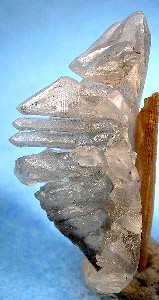
Photo: Rob Lavinsky
Sal Ammoniac
Rx: "Take of Urine {10 pounds} of Sea-Salt {2 pounds} and Wood-Soot {1 pound} boil these together into a Mass, then put them into a Subliming-Pot [an iron pot with a flat bottom] with a proper Head [This is not clear from the text. In describing the chemical preparation of Benzoin in 1729, Kazimierz Siemienowicz attached a "blind head" to his subliming pot to collect the condensate of heating.3 A blind head is an retort with no spout.4] and there will rise up what forms those Cakes this is met with in, in the [apothecary] shops.'"5
Sal Ammoniacum exists in two forms according to apothecary John Quincy: natural (which he calls Sal Armoniac) and artificial (which he calls Sal Ammoniacum Factitum). Of the natural version, Quincy explains, "The natural is found in very hot Countries, where the Earth has imbib'd the Urine of Animals; but of this little or none comes to us."6
Both John Moyle and John Tweedy identify this medicine as Sal Armoniac, which (based on Quincy's naming strategy) is the natural form. However, Quincy's comment that the natural Sal Armoniac rarely found its way to England makes it seem more likely that they were actually using the artificial form. So that is is the recipe presented here.
Description: "[Sal Ammoniacum Factitum is] a fine white Salt, which operates both by Sweat [enforced sweating was thought to be a way to purge unwanted humors from the body] and Urine, and is a good Aperient [medicine to relieve constipation] in all kinds of Obstructions. Its Dose from {20 grains to 1.5 ounces}."7
1 John Moyle, The Sea Chirurgeon, 1693, p. 32; 2 "158. John Tweedy's Bill for Medicines. November 8, 1743". Privateering and Piracy in the Colonial Period Illustrative Documents, John Franklin Jameson, ed., p. 459; 3 An Alchemists Glossary of Terms, Definitions, Formulas & Concoctions - Part 1, 3rd100.com, gathered 8/12/15; 4 Quincy, p. 280; 3 John Quincy, Pharmacopoeia Officinalis & Extemporanea, 1719, p. 279-80; 5 Kazimierz Siemienowicz, The great art of artillery of Casimir Simienowicz, 1720, p. 120; 5 An Alchemists Glossary of Terms, Definitions, Formulas & Concoctions - Part 1, 3rd100.com, gathered 8/12/15; 6,7 Quincy, p. 280
Sal Carduus Benedicti (Salt of Blessed Thistle)
Listed in: Tweedy: Sal Card. Benedict.1
Category: Chemical Medicine
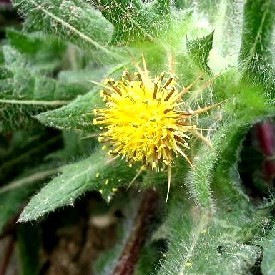
Carduus Benedicti - Blessed Thistle
Rx: Take a good Quantity of Carduus [Benedictis], when it is in its prime; pound it in a Mortar, and fill with it two thirds of a Limbeck [alembic - an alchemical still]; draw by Expression a sufficient Quanity of the Juice of other Carduus, and pour it into the Limbeck, that the Herbs swimming in the Juice may incur no Danger of sticking to the Bottom during Distillation: Fit to it a Receiver [receiving vessel] and Head, and lute [seal] the Junctures with a wet Bladder. Distil with a Fire the second Degree2 about half as much Water as you used Juice, this Water is sudorifick [sudorific - causes sweating]....
Express through a Cloth that which remains in the Limbeck, let the Juice settle, and after it has filtrated, evaporate with a small Fire about two thirds of the Liquor [liquid], in an earthen or glass Vessel: set this Vessel in a cool Place, and leave it there eight or ten Days, and keep them in a Viol well stopt. These Crystals are called the essential Salt"3.
Description: "[Sal Cardui Benedicti] is sudorific [causes sweating, though to purge bad humors from the body], the Dose is from six to sixteen Grains in its proper distilled Water"4.
1 "158. John Tweedy's Bill for Medicines. November 8, 1743". Privateering and Piracy in the Colonial Period Illustrative Documents, John Franklin Jameson, ed., p. 458; 2 "To make a Fire of the First Degree, two or three coals lighted will suffice to raise a most gentle heat. For the Fire of the second degree, three or four coals will serve, to give such a heat as is able senisibly to warm the Vessel, but so as a hand may be able to endure it for some time. For the Fire of the Third degree, you must cause heat enough to make a Pot boil, that is fill'd with five or six quarts of water. For the Fourth Degree, you must use Coals and Wood together, enough to give the most extream heat of all.", From Nicholas Lémery and Walter Harris, A course of chemistry, 1686, p. 38-9; 3,4 Nicolas Lemery & A. Bell, A Course of Chymistry, 4th ed., 1720, p. 367;
Sal Catharticum Vitriol (Purging Salt of Vitriol)
Listed in: Moyle: Sal Vitriol. Emetic1
-sulfate-heptahydrate_ben_mills.jpg)
Photo: Ben Mills - Green Vitriol (Iron II Sulfate]
Category: Chemical Medicine
Rx: "Dissolve any quantity of common martial Vitriol [green vitriol or Iron II Sulfate] in warm Water; filter the Dissolution, and put it into a Matrass [vessel with a long neck]; set it in digestion [heating to extract essential components] fifteen days. If any Fæces fall [precipitate out of the solution] in that time, carefully decant [pour] the Liquor [liquid] from them into a clean Vessel; and drop into it as much Oil of Tartar as will precipitate all its Sulphur, which will fall in a brown Powder: let it settle, and pour off the clear Liquor [liquid]. Evaporate it to a Pellicle [thin film], and set it by in a cold place to shoot into [produce] Chrystals."2
Description: "This Chrystal works by Stool, and also by Urine; and is accounted a very aperitive [opening] and cleansing Medicine. Its Dose is from {10 grains to 2 scruples or 1 dram}."3
1 John Moyle, The Sea Chirurgeon, 1693, p. 32; 2,3 John Quincy, Pharmacopoeia Officinalis & Extemporanea, 1719, p. 287
Sal Prunellæ (Crystal Mineral)
Listed in: Moyle: Sal Prunella1, Tweedy: Sal Prunel.2
Category: Chemical Medicine
Humoral Property: cool3
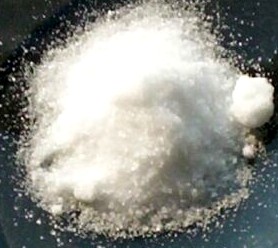
Saltpeter - Potassium Nitrate
Rx: "Melt any quantity of Salt-Petre in an earthen Pot, or very clean Iron Kettle; when it is well melted, cast a little Flower of Sulphur [gathered condensate of distilled sulphur] upon it; when that is burnt, put on more, and so do till the Nitre flows as clear as Rock Water [pure water], without any Scum: then with a clean Iron or Brass Ladle take it out of the Pot, and put it into a warm Brass Pan or Mould; when that is coagulated, put it by, and with the Ladle take out more; and so do till all the melted Salt is cast, which keep for use."4
Description: "It is diuretic and cooling, and often given in Fevers; and is very proper where a Discharge of Urine is to be encouraged. It is likewise very good in Gonorrhea's, especially when the Water scalds by its heat; for it both cleanses and cools those Parts. It is also of good service in sore Throats, and Inflammations of the Tonsils, being gently melted in the Mouth, and swallow'd with a little fine Sugar. Its Dose is from {4 grains to a dram}"5
1 John Moyle, The Sea Chirurgeon, 1693, p. 32; 2 "158. John Tweedy's Bill for Medicines. November 8, 1743". Privateering and Piracy in the Colonial Period Illustrative Documents, John Franklin Jameson, ed., p. 458; 3,4,5 John Quincy, Pharmacopoeia Officinalis & Extemporanea, 1719, p. 275
Spiritus Nitri Dulcis (Sweet Spirit of Nitre)
Listed in: Tweedy: Sp. Nitri dulc.1
Category: Chemical Medicine
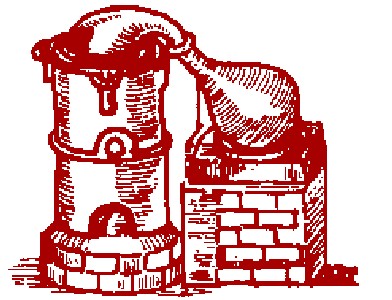
Simple Sand Furnace with Retort and Receiver, The Bottom Left
Pot is the Furnace,
the Top Left Contains Sand, Based on
The Art of Distillation, by John French (1651)
Rx: "'Put into a Retort [closed distilling vessel with a stem on the side] of Spirit of Wine tartariz'd {1/2 pound} to which add Spirit of Nitre [nitric acid] {4 ounces} by a little at a time: a crackling will ensue upon the mixture; and when that is over, put in more, and so proceed till all is in then shake them well together, and place the Retort in a Sand Furnace [a container of sand which is heated by a furnace]; fit a Receiver [receiving vessel], not luted [sealed], or but slightly: make a fire of the first degree2, proceed from thence to the second [degree], where keep it one hour and a half; and then one hour more of the third [degree] will finish the Operation.'"3
Description: "[Spiritus Nitri Dulcis] has an actual preservative, balsamic [restorative], detergent [cleansing], dissolving Virtue, and prevents Putrefaction of the Bile. [Black and yellow bile are two of the bodily humors. Putrefaction refers to their going bad and working against the body.] Being properly diluted, and prudently used, it presently gives a beautiful Whiteness to the Teeth; but if imprudently used, destroys them. It restores the Appetite, if depraved by by mucous Phlegm [another of the bodily humors], or corrupt Bile, or if the Cause proceeds from a Weakness of the Stomach. It is a great Carminative [preventer of gas formation]; it is recommended as a Preservative against the [kidney or urinary tract] Stone, and even as a Solvent for it. ...It promotes Sweat [sweating being a method for removing corrupt humors from the body], provokes Urine, allays thirst, corrects a fetid Breath, and has particular Virtues in the Scurvy. It is conveniently taken upon an empty Stomach, to twenty or thirty Drops, or more, in Wine, Mead, or Beer."4
1 "158. John Tweedy's Bill for Medicines. November 8, 1743". Privateering and Piracy in the Colonial Period Illustrative Documents, John Franklin Jameson, ed., p. 457; 2 "To make a Fire of the First Degree, two or three coals lighted will suffice to raise a most gentle heat. For the Fire of the second degree, three or four coals will serve, to give such a heat as is able senisibly to warm the Vessel, but so as a hand may be able to endure it for some time. For the Fire of the Third degree, you must cause heat enough to make a Pot boil, that is fill'd with five or six quarts of water. For the Fourth Degree, you must use Coals and Wood together, enough to give the most extream heat of all.", From Nicholas Lémery and Walter Harris, A course of chemistry, 1686, p. 38-9; 3 John Quincy, Pharmacopoeia Officinalis & Extemporanea, 1719, p. 278; 4 Robert James, Pharmacopoeia Universalis, 1747, p. 801
Spiritus Salis Ammoniaci (Spirit of Sal Amoniac)
Listed in: Tweedy: Sp. Armoniac1
Category: Chemical Medicine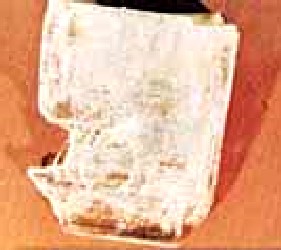
Photo: NASA - Salt of Tartar (Sodium Tartrate or Rochelle Salt)
Rx: "Take of Sal Ammoniac, and Salt of Tartar [sodium tartrate], each a like Quantity; grind them separately, then mix them together, and put them into a Glass Retort [closed vessel with a spout for distilling], and pour thereon as much Spring Water as will serve to dissolve the Salts; then distill the whole in a Sand Heat [sand furnace - a container of sand heated on a furnace], till the Salt that is caked in the Receiver [receiving vessel] is dissolved by the rising Liquor [liquid]. If the Receiver be taken away before any Moisture rises, you will obtain Sal Ammoniacum volatile, or volatile Sal Ammoniac [ammonium carbonate]."2
Description: "The alcaline Spirit of Sal Ammoniac is a Water, impregnated with as much pure alcaline Salt as it can dissolve... This Salt and Spirit instantly make a violent Effervescence with all Acids. ...If this Salt be applied to the warm Skin, and kept close to it by a Plaister, to prevent its Exhaling, it presently burns the Part with intolerable Pain, and with a violent Inflammation turns it to a black Gangrene, so that there is scarce a more sudden Poison. Whence it should seem imprudent to direct the Use of those Salts or Spirits in the Way of Smelling-Bottles, for fear of corroding and inflaming the Olfactory Nerves, the Membrane that lines the Nostrils, and the tender Vesicles of the Lungs."3
1 "158. John Tweedy's Bill for Medicines. November 8, 1743". Privateering and Piracy in the Colonial Period Illustrative Documents, John Franklin Jameson, ed., p. 457; 2 John Quincy, Pharmacopoeia Officinalis & Extemporanea, 1719, p. 793; 3 Quincy, p. 793-4
Spiritus Salis Dulcis (Sweet Spirit of Salt)
Listed in: Tweedy: Sp. Salis dulc.1
Category: Chemical Medicine
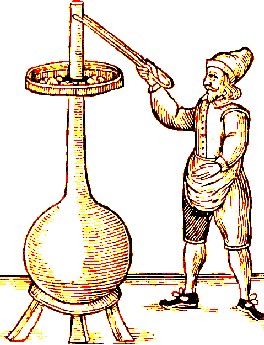
A Boltshead or Matrass, From The Art of Distillation,
By John French (1651)
Rx: "Take of Rectified Spirit of Wine, three parts.
Put it into a large bolthead [vessel with a long neck], and gradually add thereto of Spirit of Salt, one part.
Digest these together for some days; and then distill in a sand-heat [sand furnace - a container of sand, heated by a furnace], according to art; taking care, towards the end of the operation, that the retort [closed distilling vessel with a spout] break not from too great a heat.*
*The two spirits designed for making this preparation should be exceeding strong; if either of them is phlegmatic or weak, the union of the two, and consequently the medicine, will be the less perfect."2
Description: What this was used for is not clear because Tweedy's bill of medicine provides nothing more than a name. Neither of earlier sea surgeons identify this salt, probably because it appears to have been first included in the Edinburgh Pharmacopoeia in 1722, long after they wrote their books, and very near the end of the golden age of piracy. The Edinburgh pharmacopoeia does not provide a description of the vertues of this chemical medicine and none of the period dispensatories contain it.
1 "158. John Tweedy's Bill for Medicines. November 8, 1743". Privateering and Piracy in the Colonial Period Illustrative Documents, John Franklin Jameson, ed., p. 457; 2 William Lewis, Pharmacopoeia Edinburg Translated, 4th ed., 1748, p. 279
Spiritus Terebinthina (Spirit of Turpentine or Oil of Turpentine Rectified1)
Listed in: Woodall-Chest: Spirit of Terebinthine2
Category: Chemical Medicine
Humoral Property: warming3
Photo: Wiki User Antramir - Collecting Turpentine
Rx: "Take {1 pint} of oil of turpentine, and {4 pints} of water; distil the oil. This process is seldom necessary, the common oil of turpentine being usually pure enough."4
Description: "This Spirit of Terebinthine is a subtile, volatile, pure, and a christalline spirit extracted from Terebinthine, which how much the more excellent will the spirit be. It hath many precious vertues medicinable, contained in it: it is wholy combustible, penetrative, of a warming and comforting faculty: it is a good menstrum [solvent] to draw Tinctures by, either from vegetable or mineral medicines, and chiefely it is used to extract the tincture from Sulphur, which tincture is a singular good medicine many waies, as in his proper place I meane to touch. This said spirit is a true Balsame in the cure of all new wounds, especially of the sinewes. It comforteth all the sinewy parts of the body afflicted with any cold impression, as convulsions, the Scurvy, or the like. It provoketh urine very well 10 or 11 drops taken in wine tasting, and drives out [urinary tract] gravell and the [kidney or urinary tract] stone. It is also good to consolidate any inward wound penetrating into the body, a few drops thereof daily drunke. It is a fit addition to any Unguent serving for a cold disease to amend the warming force thereof, and to cause it to penetrate the better. It hath many other singular good uses, which for brevitie I must passe over."5
1 Spirit of Turpentine and Oil of Turpentine Rectified are the same thing. See James Rennie, A New Supplement to the Pharmacopœpias of London, Edinburgh, Dublin and Paris, Baldwin and Cradock, 1833, p. 408; 2 John Woodall, the surgions mate, 1617, p. 66; 3 Rennie, p. 438; 5 Woodall, p. 66-7
Spiritus Vitrioli (Spirit of Vitriol - Sulfuric Acid)
Listed in: Woodall:Spirit of Vitriol1, Tweedy: Sp. Vitriol2
Category: Chemical Medicine
Photo: Wiki User Toxic Walker - Sulfuric Acid on a Piece of Towel
Rx: "This first recited water [Phlegma Vitriol, which is distilled from Coperas (Iron II Sulfate)] being well rectified [purified through repeated distillation], separated [from impurities], and kept apart: then take the glasse Alembecke [chemical still made of a retort and receiver] ...containing the [Phlegma] Vitriol, from out of the B.M. [bain-marie - a container suspended in another containing boiling water. Used to heat gently and evenly without boiling the contents in the first container.] and place it in Arena, or a furnace with sand [a sand furnace heats a container of sand to provide gentle, even heating] according to Art, the Vitrioll within being first made into fine powder, and distill it therein so long till all the rest of the Humiditie shall be drawne from it which the B.M. had not force to exhale. This second water, you shall perceive to be a cleere and odoriferous water, onely remember that thou force not the water over strongly, but doe it by gentle fire."3
Description: "This liquor is good to purge the reynes [kidneys]; it appeaseth inward fretting and gnawing pains, taking one drachme [dram] thereof in the morning fasting with flesh broth.
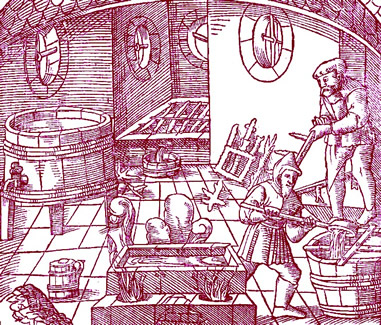
Artist: Peter Schmidt - Recovery of Vitroil (1580)
It also causeth store of urine, and moderately provoketh sweat [sweating and urination were ways to purge unwanted bodily humors]. It ceaseth the inflammations proceeding of blows or stripes [referring to lashes on the back from a whip] taken in warm broth, and mittigateth the pain thereof, but if your fire be too strong, your liquor will come over so strong, that your dose must not exceed {1 scruple} at the most: wherefore be warie thereof, for a good medicine evill handled, may do much hurt, and so will this if you want judgement to use it."4
"This sulphurous Spirit is given in Palsies and Diseases of the Lungs. The Spirit is sometimes us'd to acidulate [make slightly acid] Gargarisms and Juleps; and the Oil chiefly serves as a Menstruum [liquid solvent] in some metalline Preparations. It is extremely Caustick, and therefore is to be kept under a Wax or a Glass Stopple; for a Cork it will burn to a Cinder."5
1 John Woodall, the surgions mate, 1617, p. 45; 2 "158. John Tweedy's Bill for Medicines. November 8, 1743". Privateering and Piracy in the Colonial Period Illustrative Documents, John Franklin Jameson, ed., p. 458; 3 Woodall, p. 212; 4 Woodall, p. 212-3;5 John Quincy, Pharmacopoeia Officinalis & Extemporanea, 1719, p. 287
Tartar Vitriolatum (Potassium Sulfate)
Listed in: Tweedy: Tartar. Vitriolat.1
Category: Chemical Medicine
Photo: Ondřej Mangl -Vitriolated Tartar (Postassium Sulfate)
Rx: "Put any quantity of Oil of Tartar per Deliquium into a glass Cucurbit [vessel with a large, open top]; drop gradually upon it rectify'd [refined through repeated distillation] Oil of Vitriol till the Ebullition [bubbling] ceases: then evaporate the Humidity in a gentle Sand-Heat [sand furnace - a container of sand heated by furnace], and there will reside a very white Matter, which keep in a wide-mouth'd Glass well stopt."2
Description: "It operates [purges the body of unwanted humors] by Urine and Stool, but is too sharp and griping [causing intestinal pains] ever to be given alone: it is therefore generally us'd as an Alternative to other Deobstruents; and is particularly good in the Jaundice, and all Excesses of Choler [yellow and black choler - two of the bodily humors]. It makes a good Dentifice [toothpaste], and will render black Teeth, that are not quite rotten, as white as Ivory very soon."3
"The Virtue of this Salt is esteem'd highly opening, if taken upon an empty Stomach, diluted with Broth or Whey, and assisted with the Exercise of the Body; for thus, by attenuating, resisting Putrefaction, and stimulating, it opens the obstructed Viscera [internal organs], so as to have acquired the Name of Universal Digestive."4
1 "158. John Tweedy's Bill for Medicines. November 8, 1743". Privateering and Piracy in the Colonial Period Illustrative Documents, John Franklin Jameson, ed., p. 459; 2,3 John Quincy, Pharmacopoeia Officinalis & Extemporanea, 1719, p. 323; 4 Robert James, Pharmacopoeia Universalis, 1747, p. 781
Turbith Minerale (Yellow Precipitate)
Listed in: Moyle: Turb. Mineralis1
Category: Chemical Medicine

Quicksilver - Mercury
Rx: "Take of crude Mercury, Oyl of Vitriol separated from all the Flegm, of each equal parts, distil them in Sand [a sand furnace - a container of sand heated by a furnace], increasing the fire by degrees, till all the moisture be flown up the Air, a white mass remaining in the bottom which being separated from the crude Mercury, wash in spring water, and forthwith it will be yellow; wash it in warm water from all its accrimony, dry it, and keep it for use."2
Description: "The Dose is from two to six Grains: It is too rough for Children, but safe enough for grown Persons. This, as indeed all Preparations of this kind which are ponderous, and given in little quantity, ought not to be exhibited in Liquors [liquids], where they so suddenly fall to the bottom, as to be troublesom to take; but in Boles [soft fine clays] with Conserve of Roses, or some such things, they are not either inconvenient or unpleasant. The Turbith is accounted the most efficacious of all the Mercurial Preparations in Venereal Cases: it works smartly upwards, and will sometimes of it self raise a Spitting [spitting thought to be a way to remove bad humors from the body], if a Cathartick [purgative medicine] is not given soon after it. In virulent Gonorrohea's, and where the Humours flow to the Privy-Parts, it is of great service; but must be used with great care, and particularly [it is] not to take[n] cold. The most obstinate Leprosies generally yield to it. The Waters with which it is wash'd, is by some used for the Itch [a scabies mite infection], and other cutaneous Deformities, in which it does much good, if the Patient is not too busy with it [doesn't use it too often]"3.
1 John Moyle, The Sea Chirurgeon, 1693, p. 32; 2 Nicholas Culpeper, Pharmacopœia Londinesis, 1720, p. 264; 3 John Quincy, Pharmacopoeia Officinalis & Extemporanea, 1719, p. 261-2
Vitriolum Album (White Coperas - Zinc Sulfate)
Listed in: Woodall: Vitriolum Album1, Moyle: Vitriol Album2
Category: Chemical Medicine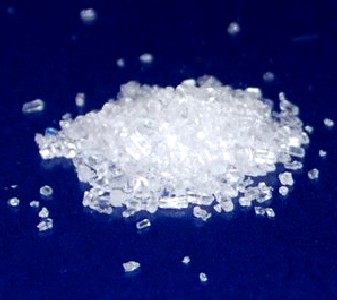
Vitriolum Album aka. White Copperas aka Zinc Sulfate
Rx: "White Coperas is easily made of other kinds of coperas [copperas refers to sulfates - for example, green coperas is iron II sulfate, blue copperas is copper sulfate, red copperas is cobalt sulfate), it is generallie called Vitriol, or white Vitriol in English, as if it were worthy a higher or more particular name, or respect, when in truth, as white waxe is made of yellow wax, by the bleaking [exposing] it in the aire, and washing it oft, so is white Coperas made of green Coperas, and is thereby, in my conceit, the weaker, onely the superfluous humiditie is thereby evaporated, and it begetteth a new kinde and shape, in all lotions it may serve in place of the other kindes of coperas, but to draw spirits from, it is weaker then any other coperas that I know."3
"Dr Brown in his Travles, tells us, that at Friburg in Germany they take the Ore, out of which Brimstone [sulfur] has been melted, and burn it again in open Air; then putting it into a large Vat, they pour Water upon it, so as to imbibe and drink in the Vitriol: this Water is afterwards boil’d to a sufficient height, and let out into Coolers; where Sticks are set in it, as in the making of Sugar-Candy: the purest chrystalliz’d Vitriol sticks to the Wood, and the rest to the Sides and Bottom."4
Description: "The cheefe uses I have made thereof, is for Collyriums or Lotions for the infimities of the eies [eyes], namelie, against itchings, akings, smarting, defluxions [flows], and opthalmia’s of the eyes, wherein I finde it to exceed either Lapis Calaminaris [calamine], Tutia, or Camphire. The salt thereof maketh also a singular vomitive medicine... the dose from {1/2 scruple to 2 drams} it is safely given.
It may very well be taken in Betony water, one spoonful. It is good against the falling Sickness [epilepsy], and in divers occasions of purging the head, also in fevers proceeding of crude and undigested humours. It provoketh appetite. ...It is good in many infirmities of the eyes, and it will keep seven years without putrefying. It cureth all itchings, smarting, immoderate rheumes [running fluids], the Opthalmia’s in their beginnings, with many other infirmities happening to the eyes, and it strengtheneth well the sight."51 John Woodall, the surgions mate, 1617, p. 112; 2 John Moyle, The Sea Chirurgeon, 1693, p. 32; 3 Woodall, p. 283-4; 4 John Quincy, Pharmacopoeia Officinalis & Extemporanea, 1719, p. 286; 5 Woodall, p. 284
White Causticke
Listed in: Woodall:The white Causticke1
Category: Chemical Medicine
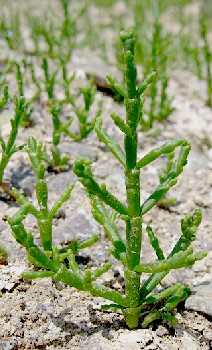
Photo: Saeed Ahmadi
Kali - Salicornia Europaea
Rx: "White caustic" does not appear to be a generally recognized name for a medicine during this period, which suggests that John Woodall uses it is more a descriptive than a recognized title. Searching Google for 'white caustic' tends to result in finding Lixivium (or lye), probably because it is white and is also called by the name caustic soda. However, since Woodall lists this separately in from Lixivium and Lixivium Forte his book2, it does not appear to be the same thing, at least in Woodall's mind.
Woodall does say, "This kind of Causticke taketh his vertue from the vegetable salt it containes"3 which he elsewhere identifies as as being salts that come from plants4. So we know it is plant-based.
Physician Robert James states that alkalai salts are "salts of Vegetables procu red[sic] by burning them from Kali [Salicornia - a salt-tolerant flowering plant of the Amaranthaceae family] ....a Herb replete with Salt, which grows about the Sea Shore, and the banks of the Nile, and also those of the celebrated River Belus in Syria"5. James further explains that to prepare salts, the plant is burnt and the leftover "Ashes are boiled in Water, where they yield a strong acid salt Lixivium or Lye consisting of Salt communicated to the Water when being properly separated... If this Lixivium or Lye is evaporated to a Dryness in and Iron Vessel, a white solid Mass, of a most acrid caustic Taste and perfectly soluble in Water, is left behind."6
This sounds remarkably like Woodall's White Caustic. (Keep in mind that terms were much looser during this time and that 'Lixivium' could be used to refer to a wide variety of plant-based substances prepared in this way.)
Description: "This kind of Causticke ...may well be carried in the Chest, for that it will last well an East India Voyage, with some times the addition of a little capitall Lees ['Lees' are the dregs drawn from potash and

Photo: Wiki user Walkerma - Lye (Sodum Hydroxide) Pellets
lime.7], as neede shall require, namely when it groweth too hard. It is altogether as safe and as sure as the Causticke stone, but not so swift in working, neither so well to bee ruled, for it will often spread three times as wide as it is intended, if it be not warily prevented... It is not sufficient[ly] safe to cut a hole... in a spread Emplaster of the bignesse he would have his orifice, and so lay it on, and cover it with a like Emplaster: for that this course cannot hinder the spreading thereof [Woodall is saying the white caustic will seep out and burn areas outside of the hole made in a plaster], but if hee
will worke surely after that fashion ...let him cut from a rowle [roll] of some soft Emplaster that will cleave well, a peece of [the caustic] {1 ounce} in weight, or thereabout, and make of it two long rowles, laying one on e[a]ch side the place of the Aposteme appointed to be pierced, bringing them at e[a]ch end together, for the ends of a Causticke incision ought to be narrow, and the middest broad ...in Buboes [swellings] of the emunctories [any part of the body that removes waste] it [the caustic] will seldome fall out so, for that you are constrained to follow the forme of the tumour, which commonly lieth thwart, chiefly in veneriall Buboes in Inguine or the groyne. Like wise if the tumour be full, and the Patient in great paine, you shall doe him great ease by piercing the Easker [eschar – dead tissue] in the middest, so soone as it is made to discharge some of the matter."8
1 John Woodall, the surgions mate, 1617, p. 67; 2 See Woodall, p. 63; 3 Woodall, p. 67; 4 Woodall explains, "under the name of vegetable salt, are comprehended the salts of trees and hearbs, and whatsoever else may grow by sowing or planting, or any other industry of man, as well the seed as the fruit, or the plant itselfe, or any part thereof", p. 271; 5,6 Robert James, Pharmacopœia universalis, p. 63; 7 "Soap", Encyclopedia Britannica, Fourth Edition, Vol XIX, p. 433; 8 Woodall, p. 67-8

